(英文版)大学物理-力学
大学物理英文版的中文词汇对照表

Conductors & dielectrics in electrostatic fieldDielectric 电介质 Electrostatic equilibrium 静电平衡 Polarization 极化 Relative permittivity of dielectric 电介质的相对电容率 Electric susceptibility 电极化率 Electric displacement 电位移矢量 Metal 金属 Capacitor 电容器 Capacitance 电容 Farad 法拉 Breakdown field strength (dielectric strength) 击穿电场强度 (电介质绝缘强度) Parallel combination 并联 Series combination 串联 Energy of electrostatic field 静电场的能量Electrostatic induction 静电感应 Electrostatic shield 静电屏蔽 Coaxial 同轴的 Isotropic 各向同性的 Free charge 自由电荷 Polarized charge 极化电荷 Electric polarization 电极化强度 Permittivity of dielectric 电介质的电容率 Gauss’s law with dielectric 电介质中的高斯定理 Conducting 导电的 Parallel-plate capacitor 平行板电容器 Cylindrical capacitor 圆柱形电容器 Spherical capacitor 球形电容器 Energy density of electrostatic filed 静电场的能量密度Magnetic forces & magnetic fieldsMagnetic field 磁场 Steady current 恒定电流 Electric current 电流 Drift speed 漂移速率 Magnetic induction 磁感应强度 The Biot-Savart law 毕奥-萨伐尔定律 Infinitesimal 无限小的 Permeability of free space 真空磁导率 Principle of superposition of magnetic induction 磁感应强度叠加原理 Loop, Coil 线圈 Solenoid 螺线管 Angular velocity 角速度 Magnetic flux 磁通量 Gauss’s law in magnetic fieldSteady magnetic field 恒定磁场 Electromotive force (emf) 电动势 Current density 电流密度 Conduction current 传导电流 Ampere 安培 Circuit 电路,回路 Magnet 磁铁 Tesla 特斯拉 Current element 电流元 Right-hand rule 右手螺旋定则 Current-carrying 载流的 Extending line 延长线 Magnetic moment 磁矩 Magnetic induction lines 磁感应线 Ampere’s loop law 安培环路定理磁场中的高斯定理 Clockwise 顺时针的 Anticlockwise (counterclockwise) 逆时针的 Ideal 理想的 Closed path 闭合路径 Turn 匝,圈 Lorentz force 洛伦兹力 Ampere force 安培力 period 周期 Ampere law 安培定律 Torque 转矩 Magnetization 磁化Rectangle 长方形的 Cross section 截面 Toroid 螺绕环 Closely spaced 密绕的 Magnetic medium 磁介质 Ampere’s loop law in magnetic medium 磁介质中的安培环路定理 Magnetic permeability 磁导率 Relative magnetic permeability 相对磁导率 Magnetization intensity 磁化强度 Magnetization current 磁化电流 Magnetic field intensity 磁场强度Faraday’s law & inductanceFaraday’s law of induction 法拉第电磁感应定律 Induction electromotive force 感应电动势 Magnetic flux linkage 磁链 Vary 变化 Motional electromotive force 动生电动势 Bar 棒 Pivot 支点 Induced electric field 感生电场 Mutual inductance electromotive force 互感电动势 Henry 亨利 Energy of magnetic field 磁场的能量 Energy density of magnetic field 磁场的能量密度 Cable 电缆 Displacement current 位移电流 Full current 全电流Induction current 感应电流 Lenz’s law 楞次定律 Move away from 离开 Upwards 向上 Downwards 向下 Induced electromotive force 感生电动势 Electromagnetic field 电磁场 Self-inductance electromotive force 自感电动势 Self-inductance 自感 Mutual-inductance 互感 Volume element 体积元 Displacement current density 位移电流密度 Ampere’s loop law in full current 全电流安培环路定理 Maxwell electromagnetism theorem 麦克斯韦电磁场理论 Maxwell’s equations 麦克斯韦方程组。
大学物理-力学课件(全)

牛顿第二定律
总结词
描述力对物体转动效应的定律。
详细描述
力的矩与转动定律指出,力矩是力和力臂的乘积,其方向垂直于力和力臂所在的平面。公式表示为M=FL,其中M表示力矩,F表示作用力,L表示力臂。转动定律则说明,对于定轴转动系统,系统的角加速度与作用于转轴上的合力矩成正比,与转动惯量成反比。
力的矩与转动定律
万有引力定律
04
CHAPTER
弹性力学
能够恢复其原始形状和大小的物体。
弹性体定义
线弹性体、非线弹性体、超弹性体等。
弹性体的分类
杨氏模量、泊松比等。
弹性体的物理属性
拉伸、压缩、弯曲、剪切等。
弹性体的变形
弹性体的基本性质
物体内部相邻部分之间的相互作用力。
弹性体的应力与应变
应力定义
正应力和剪应力。
应力的分类
动量的计算方法
动量与动量守恒定律
在没有外力作用的情况下,一个系统内各个物体的动量总和保持不变。这一定律是经典力学中重要的基本定律之一,适用于宏观低速的物体系统。
动量守恒定律
通过分析系统的受力情况和动量变化情况,根据动量守恒定律可以求出系统内各个物体的动量和速度变化情况。在解决实际问题时,通常需要先对系统进行受力分析和动量分析,然后根据动量守恒定律列方程求解。
应用方法
动量与动量守恒定律
02
CHAPTER
运动学
描述物体位置变化的物理量,表示为矢量,由起点指向终点的有向线段。
位移
描述物体运动快慢的物理量,等于位移对时间的导数,表示为矢量。
速度
位移与速度
加速度
描述物体速度变化快慢的物理量,等于速度对时间的导数,表示为矢量。
(英文版)大学物理-力学
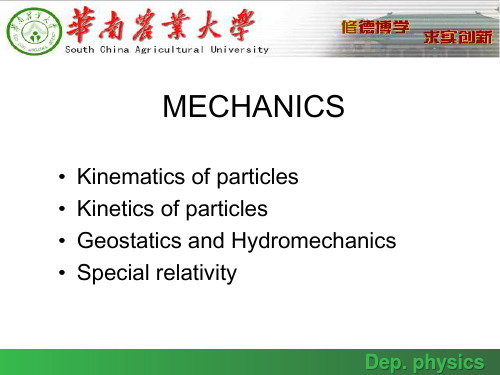
By derivative
16
v0
〔例〕平静的湖面上有一小船,一人在湖边处
有一定高度的岸上以匀速率v0收绳子,使小船
L
向岸边靠拢,求小船的运动速度。
H
解:选取坐标如图,O是固定点。有:
0
x
v
dx dt
(这是本题的关键)
v0
dL dt
x L2 H 2
v dx dt
L dL dt
L2 H 2
2
Dep. physics
1. Base conception
• Particles
to describe an object whose parts all move in exactly the same way. Even a complex object can be treated as a particle if there are no internal motions.
24
(例)一人划船渡江,江水的流速为2.0km/h,船相对江水的速率为4.0km/h,
江水宽1.0km,若想用最短时间渡江,人应该按什么方向划行?要经过多长时间
渡过江去?
y
解:如图所示建立坐标系
设船对地的速度方向与江对地的速
度方向夹角为 ,江对地的速度
方向与船对江的速度方向为
则:
v船地
v船江
sin(180o ) sin
• Velocity vector
① average velocity ② instantaneous velocity
v
v v
Vr
Vt
vv
v v
limVrdrVt0 Vt dtDep. physics
大学学科的英文版
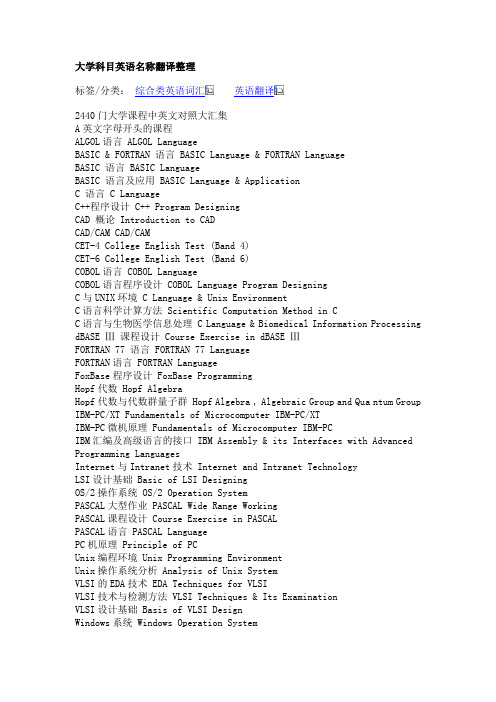
大学科目英语名称翻译整理标签/分类:综合类英语词汇英语翻译2440门大学课程中英文对照大汇集A英文字母开头的课程ALGOL语言 ALGOL LanguageBASIC & FORTRAN 语言 BASIC Language & FORTRAN LanguageBASIC 语言 BASIC LanguageBASIC 语言及应用 BASIC Language & ApplicationC 语言 C LanguageC++程序设计 C++ Program DesigningCAD 概论 Introduction to CADCAD/CAM CAD/CAMCET-4 College English Test (Band 4)CET-6 College English Test (Band 6)COBOL语言 COBOL LanguageCOBOL语言程序设计 COBOL Language Program DesigningC与UNIX环境 C Language & Unix EnvironmentC语言科学计算方法 Scientific Computation Method in CC语言与生物医学信息处理 C Language & Biomedical Information Processing dBASE Ⅲ课程设计 Course Exercise in dBASE ⅢFORTRAN 77 语言 FORTRAN 77 LanguageFORTRAN语言 FORTRAN LanguageFoxBase程序设计 FoxBase ProgrammingHopf代数 Hopf AlgebraHopf代数与代数群量子群 Hopf Algebra , Algebraic Group and Qua ntum Group IBM-PC/XT Fundamentals of Microcomputer IBM-PC/XTIBM-PC微机原理 Fundamentals of Microcomputer IBM-PCIBM汇编及高级语言的接口 IBM Assembly & its Interfaces with Advanced Programming LanguagesInternet与Intranet技术 Internet and Intranet TechnologyLSI设计基础 Basic of LSI DesigningOS/2操作系统 OS/2 Operation SystemPASCAL大型作业 PASCAL Wide Range WorkingPASCAL课程设计 Course Exercise in PASCALPASCAL语言 PASCAL LanguagePC机原理 Principle of PCUnix编程环境 Unix Programming EnvironmentUnix操作系统分析 Analysis of Unix SystemVLSI的EDA技术 EDA Techniques for VLSIVLSI技术与检测方法 VLSI Techniques & Its ExaminationVLSI设计基础 Basis of VLSI DesignWindows系统 Windows Operation SystemX光分析 X-ray AnalysisX射线金属学 X-Ray & MetallographyX射线与电镜 X-ray & Electric MicroscopeZ-80汇编语言程序设计 Z-80 Pragramming in Assembly LanguagesB开头的课程板壳非线性力学 Nonlinear Mechanics of Plate and Shell板壳理论 Plate Theory , Theory of Plate and Shell板壳力学 Plate Mechanics办公自动化 Office Automatization办公自动化系统毕业设计 Office Automatization Thesis办公自动化系统设计 Office Automatization Design半波实验 Semiwave Experiment半导体变流技术 Semiconductor Converting Technology半导体材料 Semiconductor Materials半导体测量 Measurement of Semiconductors半导体瓷敏元件 Semiconductor Porcelain-Sensitive Elements半导体光电子学 Semiconductor Optic Electronics半导体化学 Semiconductor Chemistry半导体激光器 Semiconductor Laser Unit半导体集成电路 Semiconductor Integrated Circuitry半导体理论 Semi-conductive Theory半导体器件 Semiconductor Devices半导体器件工艺原理 Technological Fundamentals of Semiconductor Device 半导体器件课程设计 Course Design of Semiconductor Devices半导体物理 Semiconductor Physics半导体专业 Semi-conduction Specialty半导体专业实验 Specialty Experiment of Semiconductor半群理论 Semi-group Theory保健食品监督评价 Evaluation and Supervision on Health Food s保险学 Insurance保险学 Insurance报告文学专题 Special Subject On Reportage报刊编辑学 Newspaper & Magazine Editing报刊选读 Selected Readings of Newspaper & Magazine报纸编辑学 Newspaper Editing泵与风机 Pumps and Fans泵与水机 Pumps & Water Turbines毕业论文 Graduation Thesis毕业设计 Graduation Thesis毕业实习 Graduation Practice编译方法 Compilation Method编译方法 Methods of Compiling编译技术 Technique of Compiling编译原理 Fundamentals of Compiling, Principles of Compiler编译原理课程设计 Course Design of Compiling变电站的微机检测 Computer Testing in Transformer Substation变电站的微机检测与控制 Computer Testing & Control in Transformer Substation变分法与张量 Calculus of Variations & Tensor变分学 Calculus of Variations变流技术 Semiconductor Converting Technology变质量系统热力学与新型回转压 Variable Quality System Thermal Mechanics & NeoRo表面活性剂化学及应用 Chemistry and Application of Surfactant表面活性物质 Surface Reactive Materials并行处理 Parallel Processing并行处理与并行程序设计 Parallel Processing and Parallel Programming 并行算法 Parallel Algorithmic波谱学 Spectroscopy, Wave Spectrum波谱学实验 Spectroscopic Experiment薄膜光学 Film Optics薄膜物理 Thin Film Physics不育症的病因学 Etiology of InfertilityC开头的课程材料的力学性能测试 Measurement of Material Mechanical Performance材料化学 Material Chemistry材料力学 Mechanics of Materials财税法规与税务会计 Laws and Regulations of Finance and Taxes财务案例分析 Case Analysis of Finance Management财务案例分析 Case Analysis of Financial Management财务报告分析 Analysis of Financial Statement财务成本管理 Financial Cost Management财务管理 Financial Management, Financial Cost Management财务管理与分析 Financial Management and Analysis财务会计 Financial Accountancy财政学 Public Finance财政与金融 Finance & Banking财政与税收 Finance & Revenue财政与税收理论 Theories on Public Finance and Tax Revenue财政与信贷 Finance & Credit操作系统 Disk Operating System (DOS)操作系统课程设计 Course Design in Disk Operating System操作系统与编译原理 Disk Operating System & Fundamentals of Compiling 操作系统原理 Fundamentals of Disk Operating System, Principles of Operating System测量技术基础 Foundation of Measurement Technology测量原理与仪器设计 Measurement Fundamentals & Meter Design测试技术 Testing Technology测试与信号变换处理 Testing & Signal Transformation Processing策波测量技术 Technique of Whip Wave Measurement策略管理 Strategic Management产品学 Production产业经济学 Industrial Economy产业组织 Industrial Organization产业组织学 Industrial Organization Technology常微分方程 Ordinary Differential Equations场论 Field Theory超导磁体及应用 Superconductive Magnet & Application超导及应用 Superconductive & Application超高真空科学与技术 Science and Technology of Ultrahigh Vacuum 60超精密加工和微细加工 Super-Precision & Minuteness Processing超精微细加工 Super-Precision & Minuteness Processing超声及应用 Supersonics Application成本会计 Cost Accounting成像原理与技术 Principles & Technique of Imaging成组技术 Grouping Technique城市规划原理 Fundamentals of City Planning城市社会学 Urban Sociology程控数字交换 Program Controlling of Digital Exchange程序设计 Program Designing程序设计方法学 Methodology of Programming, Methods of Programming程序设计及算法语言 Program Designing & Algorithmic Language程序设计语言 Programming Language齿轮啮合原理 Principles of Gear Connection冲击测量及误差 Punching Measurement & Error冲压工艺 Sheet Metal Forming Technology抽象代数 Abstract Algebra初等数学 Primary Mathematics传坳概论 Introduction to Pass Col传动概论 Introduction to Transmission传感技术 Sensor Technique传感技术及应用 Sensor Technique & Application传感器及应用 Sensors & Application传感器与检测技术 Sensors & Testing Technology传感器原理 Fundamentals of Sensors传感器原理及应用 Fundamentals of Sensors & Application传热学 Heat Transfer船舶操纵 Ship Controlling船舶电力系统 Ship Electrical Power System船舶电力系统课程设计 Course Exercise in Ship Electrical Power System船舶电气传动自动化 Ship Electrified Transmission Automation船舶电站 Ship Power Station船舶动力装置 Ship Power Equipment船舶概论 Introduction to Ships船舶焊接与材料 Welding & Materials on Ship船舶机械控制技术 Mechanic Control Technology for Ships船舶机械拖动 Ship Mechanic Towage船舶建筑美学 Artistic Designing of Ships船舶结构 Ship Structure船舶结构力学 Structural Mechanics for Ships船舶结构与制图 Ship Structure & Graphing船舶静力学 Ship Statics船舶强度与结构设计 Designing Ship Intensity & Structure船舶设计原理 Principles of Ship Designing船舶推进 Ship Propelling船舶摇摆 Ship Swaying船舶摇摆与操纵 Ship Swaying & Manipulating船舶振动 Ship Vibration船舶阻力 Ship Resistance船体建造工艺 Ship-Building Technology船体结构 Ship Structure船体结构图 Ship Structure Graphing船体结构与制图 Ship Structure & Graphing船体振动学 Ship Vibration船体制图 Ship Graphing船用电器设备 Marine Electrical Equipment创造心理学 Creativity Psychology词汇学 Lexicology磁测量技术 Magnetic Measurement Technology磁传感器 Magnetic Sensor磁存储设备设计原理 Fundamental Design of Magnetic Memory Equipment 磁记录 Magnetographic磁记录技术 Magnetographic Technology磁记录物理 Magnetographic Physics磁路设计与场计算 Magnetic Path Designing & Magnetic Field Calculati 磁盘控制器 Magnetic Disk Controler磁性材料 Magnetic Materials磁性测量 Magnetic Measurement磁性物理 Magnetophysics磁原理及应用 Principles of Catalyzation & Application催化原理 Principles of CatalysisD开头的课程大电流测量 Super-Current Measurement大电源测量 Super-Power Measurement大机组协调控制 Coordination & Control of Generator Networks大跨度房屋结构 Large-Span House structure大型锅炉概况 Introduction to Large-Volume Boilers大型火电机组控制 Control of Large Thermal Power Generator Networks大型数据库原理与高级开发技术 Principles of Large-Scale Data-Bas e and Advanced Development Technology大学德语 College German大学俄语 College Russian大学法语 College French大学日语 College Japanese大学生心理学 Psychology Introduction大学物理 College Physics大学物理实验 Experiment of College Physics大学英语 College English大学语文 College Chinese大众传播学 Mass Media代数几何 Algebraic Geometry代数几何Algebraic Geometry代数曲面 Algebraic Surfaces代数图论 Algebraic Graph Theory代数拓扑 Algebraic Topology代数学 Algebra代用燃料 Substitute Fuel代用运放电路 Simulated Transmittal Circuit单片机与接口技术 Mono-Chip Computers & Interface Technique单片机原理 Fundamentals of Mono-Chip Computers单片机原理及应用 Fundamentals of Mono-Chip Computers & Applications 弹塑性力学 Elastic-Plastic Mechanics弹性波 Elastic Waves弹性力学 Elastic Mechanics, Theory of Elastic Mechanics弹性元件的理论及设计 Theory and Design of Elastic Element蛋白质结构基础 Principle of Protein Structure蛋白质生物化学技术 Biochemical Technology of Protein当代国际关系 Contemporary International Relationship当代国外社会思维评价 Evaluation of Contemporary Foreign Social Thought 当代文学 Contemporary Literature当代文学专题 Topics on Contemporary Literature当代西方哲学 Contemporary Western Philosophy当代戏剧与电影 Contemporary Drama & Films当代资本主义经济 Contemporary Capitalist Economy党史 History of the Party导波光学 Wave Guiding Optics德育 Moral Education等离子体工程 Plasma Engineering低频电子线路 Low Frequency Electric Circuit低温测试技术 Cryo Testing Technique低温传热学 Cryo Conduction低温固体物理 Cryo Solid Physics低温技术原理与装置 Fundamentals of Cryo Technology & Equipment低温技术中的微机原理 Priciples of Microcomputer in Cryo Technology 低温绝热 Cryo Heat Insulation低温气体制冷机 Cryo Gas Refrigerator低温热管 Cryo Heat Tube低温设备 Cryo Equipment低温生物冻干技术 Biological Cryo Freezing Drying Technology低温生物学原理与应用 Principle & Application of Cryobiology低温实验技术 Cryo Experimentation Technology低温物理导论 Cryo Physic Concepts低温物理概论 Cryo Physic Concepts低温仪表及测试 Cryo Meters & Measurement低温原理 Cryo Fundamentals低温原理与设备 Cryo Fundamentals & Equipment低温制冷机 Cryo Refrigerator低温中的微机应用 Application of Microcomputer in Cryo Technology低温装置 Cryo Equipment低噪声电子电路 Low-Noise Electric Circuit低噪声电子设计 Low-Noise Electronic Designing低噪声放大与弱检 Low-Noise Increasing & Decreasing低噪声与弱信号检测 Detection of Low Noise & Weak Signals地基基础课程设计 Course Design of Groundsill Basis地理 Geography第二次世界大战史 History of World War II典型计算机分析 Classical Computer Analysis电测量技术 Electric Measurement Technology电厂计算机控制系统 Computer Control System in Power Plants电磁测量实验技术 Electromagnetic Measurement Experiment & Technology 电磁场计算机 Electromagnetic Field Computers电磁场理论 Theory of Electromagnetic Fields电磁场数值计算 Numerical Calculation of Electromagnetic Fields电磁场与电磁波 Electromagnetic Fields & Magnetic Waves电磁场与微波技术 Electromagnetic Fields & Micro-Wave Technology电磁场中的数值方法 Numerical Methods in Electromagnetic Fields电磁场中的数值计算 Numerical Calculation in Electromagnetic Fields 电磁学 Electromagnetics电动力学 Electrodynamics电镀 Plating电分析化学 Electro-Analytical Chemistry电工材料 Electrical Materials电工测量技术基础 Measurement Technology of Electrical Engineering电工测试技术基础 Testing Technology of Electrical Engineering电工产品学 Electrotechnical Products电工电子技术基础 Electrical Technology & Electrical Engineering电工电子学 Electronics in Electrical Engineering电工基础 Fundamental Theory of Electrical Engineering电工基础理论 Fundamental Theory of Electrical Engineering电工基础实验 Basic Experiment in Electrical Engineering电工技术 Electrotechnics电工技术基础 Fundamentals of Electrotechnics电工实习 Electrical Engineering Practice电工实验 Experiment of Electrical Engineering电工实验技术基础 Experiment Technology of Electrical Engineering电工学 Electrical Engineering电工与电机控制 Electrical Engineering & Motor Control电弧电接触 Electrical Arc Contact电弧焊及电渣焊 Electric Arc Welding & Electroslag Welding电化学测试技术 Electrochemical Measurement Technology电化学工程 Electrochemical Engineering电化学工艺学 Electrochemical Technology电机 Motor电机测试技术 Motor Measuring Technology电机电磁场的分析与计算 Analysis & Calculation of Electrical Motor & 电机电磁场的数值计算 Calculation of Electrical Motor & Electromagnetic Fields电机电磁场理论 Theory of Electrical Moto & Electromagnetic Fields电机电器与供电 Motor Elements and Power Supply电机矩阵分析法 Analysis of Electrical Motor Matrix电机课程设计 Course Exercise in Electric Engine电机绕组理论 Theory of Motor Winding电机绕组理论及应用 Theory & Application of Motor Winding电机设计 Design of Electrical Motor电机瞬变过程 Electrical Motor Change Processes电机统一理论 Theory of Electrical Motor Integration电机学 Electrical Motor电机学及控制电机 Electrical Machinery Control & Technology电机与拖动 Electrical Machinery & Towage电机原理 Principle of Electric Engine电机原理与拖动 Principles of Electrical Machinery & Towage电机专题 Lectures on Electric Engine电接触与电弧 Electrical Contact & Electrical Arc电介质物理 Dielectric Physics电镜 Electronic Speculum电力电子电路 Power Electronic Circuit电力电子电器 Power Electronic Equipment电力电子器件 Power Electronic Devices电力电子学 Power Electronics电力工程 Electrical Power Engineering电力企业管理 Management of Electrical Enterprise电力生产技术 Technology of Electrical Power Generation电力生产优化管理 Optimal Management of Electrical Power Generation电力拖动 Electric Traction电力拖动基础 Fundamentals for Electrical Towage电力拖动控制系统 Electrical Towage Control Systems电力拖动与电气控制 Electrical Towage & Electrical Control电力系统 Power Systems电力系统电源最优化规划 Optimal Planning of Power Source in a Power System 电力系统短路 Power System Shortcuts电力系统分析 Power System Analysis电力系统规划 Power System Planning电力系统过电压 Hyper-Voltage of Power Systems电力系统继电保护原理 Power System Relay Protection电力系统经济分析 Economical Analysis of Power Systems电力系统经济运行 Economical Operation of Power Systems电力系统可靠性 Power System Reliability电力系统可靠性分析 Power System Reliability Analysis电力系统课程设计 Course Design of Power Systems电力系统无功补偿及应用 Non-Work Compensation in Power Systems & Applicati电力系统谐波 Harmonious Waves in Power Systems电力系统优化设计 Optimal Designing of Power Systems电力系统远动 Operation of Electric Systems电力系统远动技术 Operation Technique of Electric Systems电力系统运行 Operation of Electric Systems电力系统自动化 Automation of Electric Systems电力系统自动装置 Power System Automation Equipment电力系统最优规划 Optimal Planning in Power System电力装置课程设计 Course Design of Power Equipment电力装置与系统 Power Equipment & System电路测量与实验 Circuit Measurement & Experiment电路测试技术 Circuit Measurement Technology电路测试技术基础 Fundamentals of Circuit Measurement Technology电路测试技术及实验 Circuit Measurement Technology & Experiments电路分析基础 Basis of Circuit Analysis电路分析基础实验 Basic Experiment on Circuit Analysis电路分析实验 Experiment on Circuit Analysis电路和电子技术 Circuit and Electronic Technique电路基本理论 Basis Theory of Circuitry电路及电子线路CAD Circuitry CAD电路理论 Theory of Circuit电路理论基础 Fundamental Theory of Circuit电路理论实验 Experiments in Theory of Circuct电路设计与测试技术 Circuit Designing & Measurement Technology电气测量技术 Electrical Measurement Technology电气传动 Electrified Transmission电气控制技术 Electrical Control Technology电器设计 Electrical Appliances Designing电器学 Electrical Appliances电器与控制 Electrical Appliances & Control电生理技术基础 Basics of Electricphysiological Technology电视传感器图象显示 Television Sensor Graphic Display电视接收技术 Television Reception Technology电视节目 Television Programs电视节目制作 Television Program Designing电视新技术 New Television Technology电视新闻 Television News电视原理 Principles of Television电网调度自动化 Automation of Electric Network Management电学实验 Electrical Experiment电影艺术 Art of Film Making电站微机检测控制 Computerized Measurement & Control of Power Statio 电子材料与元件测试技术 Measuring Technology of Electronic Material and Element电子材料元件 Electronic Material and Element电子材料元件测量 Electronic Material and Element Measurement电子测量与实验技术 Technology of Electronic Measurement & Experiment 电子测试 Electronic Testing电子测试技术 Electronic Testing Technology电子测试技术与实验 Electronic Testing Technology & Experiment电子测试实验 Electronic Testing Experiment电子测试与实验技术 Electronic Testing Technology & Experiment电子机械运动控制技术 Technology of Electronic Mechanic Movement Control 电子技术 Technology of Electronics电子技术腐蚀测试中的应用 Application of Electronic Technology in Erosion Measurement电子技术基础 Basic Electronic Technology电子技术基础与实验 Basic Electronic Technology & Experiment电子技术课程设计 Course Exercise in Electronic Technology电子技术实验 Experiment in Electronic Technology电子技术综合性设计实验 Experiment in Electronic Technology电子理论实验 Experiment in Electronic Theory电子商务 Electronic Commerce电子系统的ASIC技术 ASIC Design Technologies电子显微分析 Electronic Micro-Analysis电子显微镜 Electronic Microscope电子线路 Electronic Circuit电子线路的计算机辅助设计 Computer Associate Design of Electronic Circuit电子线路课程设计 Course Design of Electronic Circuit电子线路设计与测试技术 Electronic Circuit Design & Measurement Technology电子线路设计与测试实验 Electronic Circuit Design & Measurement Experiment电子线路实验 Experiment in Electronic Circuit电子学 Electronics电子学课程设计 Course Design of Electronics电子照相技术 Electronic Photographing Technology雕塑艺术欣赏 Appreciation of Sculptural Art调节原理 Principles of Regulation调节装置 Regulation Equipment动力机械CAD Dynamical Machine CAD动力学 Dynamics动态规划 Dynamic Programming动态无损检测 Dynamic Non-Destruction Measurement动态信号 Dynamic Signal动态信号分析与仪器 Dynamic Signal Analysis & Apparatus动物病害学基础 Basis of Animal Disease动物免疫学 Animal Immunology动物生理与分子生物学 Animal Physiology and Molecular Biochemistry 动物学 Zoology动物遗传工程 Animal Genetic Engineering毒理遗传学 Toxicological Genetics断裂力学 Fracture Mechanics断裂疲劳力学 Fatigue Fracture Mechanics锻压测试技术 Forging Testing Technique锻压工艺 Forging Technology锻压机械液压传动 Hydraulic Transmission in Forging Machinery锻压加热设备 Forging Heating Equipment锻压设备专题 Lectures on Forging Press Equipments锻压系统动力学 Dynamics of Forging System锻造工艺 Forging Technology锻造加热设备 Forging Heat Equipment对外贸易保险 International Trade Insurance对外贸易地理 International Marketing Geography对外贸易概论 Introduction to International Trade对外贸易运输 International Trade Transportation多层网络方法 Multi-Layer Network Technology多复变函数 Analytic Functions of Several Complex Variables多媒体计算机技术 Multimedia Computer Technology多媒体技术 Multimedia Technology多目标优化方法 Multipurpose Optimal Method多项距阵 Multi-Nominal Matrix多元统计分析 Multivariable StatisticsF开头的课程发电厂 Power Plant发电厂电气部分 Electric Elements of Power Plants发电厂电气部分与动力部分 Electric Elements & Dynamics of Power Plants 发电厂电气部分与热力设备 Electric Elements & Thermodynamics Equipment of Power Plants发电厂计算机控制 Computer Control in Power Plant发酵工程 Zymolysis Engineering发育生物学原理与实验技术 Principle and Experimental Technology of Development发展经济学 Evolutive Economics法理学 Nomology法律基础 Fundamentals of Law法学概论 An Introduction to Science of Law法学基础 Fundamentals of Science of Law翻译 Translation翻译理论与技巧 Theory & Skills of Translation反不正当经济法 Anti-malfeasance Economic Law泛读 Extensive Reading泛函分析 Functional Analysis泛函分析 Functional Analysis房屋建筑学 Architectural Design & Construction房屋建筑学课程设计 Course Design of House Architecture仿真与辅助设计 Simulation & Computer Aided Design放射生物学 Radiation Biology放射学 Radiology非电量测量 Non-Electricity Measurement非金属材料 Non-Metal Materials非线性采样系统 Non-Linear Sampling System非线性方程组的数值解法 Numerical Methods for No-linear System s of Equations非线性光学 Nonlinear Optics非线性规划 Non-Linear Programming非线性控制理论 Non-Linear Control Theory非线性双曲型守恒律解的存在性 The Existence of Solutions for Non -linear Hyperbolic Conservation Laws非线性物理导论 Introduction to Nonlinear Physics非线性振荡 Non-Linear Oscillation非线性振动 Nonlinear Vibration废水处理工程 Technology of Wastewater Treatment废水处理与回用 Sewage Disposal and Re-use沸腾燃烧 Boiling Combustion分布式计算机系统 Distributed Computer System / Distributed System分布式系统与分布式处理 Distributed Systems and Distributed Processing 分离科学 Separation Science分析化学 Analytical Chemistry分析化学实验 Analytical Chemistry Experiment分析力学 Analytic Mechanics分析生物化学 Analytical Biochemistry分析生物化学 Analytical Biochemistry分子病毒学 Molecular Virology分子进化工程 Engineering of Molecular Evolution分子生物学 Molecular Biology分子生物学技术 Protocols in Molecular Biology分子遗传学 Molecular Genetics风机调节 Fan Regulation风机调节.使用.运转 Regulation, Application & Operation of Fans风机三元流动理论与设计 Tri-Variant Movement Theory & Design of Fans 风能利用 Wind Power Utilization风险投资分析 Analysis of Risk Investment服务业营销 Service Industry Marketing辅助机械 Aided Machine腐蚀电化学实验 Experiment in Erosive Electrochemistry复变函数 Complex Variables Functions复变函数与积分变换 Functions of Complex Variables & Integral Transformation复合材料结构力学 Structural Mechanics of Composite Material复合材料力学 Compound Material Mechanics傅里叶光学 Fourier OpticsG开头的课程概率论 Probability Theory概率论与数理统计 Probability Theory & Mathematical Statistics概率论与随机过程 Probability Theory & Stochastic Process概率与统计 Probability & Statistics钢笔画 Pen Drawing钢的热处理 Heat-Treatment of Steel钢结构 Steel Structure钢筋混凝土 Reinforced Concrete钢筋混凝土及砖石结构 Reinforced Concrete & Brick Structure钢砼结构 Reinforced Concrete Structure钢砼结构与砌体结构 Reinforces Structure and Monsary Structure钢砼课程设计 Reinforced Concrete Course Design钢砼设计 Experiment of Reinforced Concrete Structure高层建筑基础 Tall Building Foundation高层建筑基础设计 Designing bases of High Rising Buildings高层建筑结构设计 Designing Structures of High Rising Buildings高等材料力学 Advanced Material Mechanics高等代数 Advanced Algebra高等发光分析 Advanced Luminescence Analysis高等分析化学 Advanced Analytical Chemistry高等工程力学 Advanced Engineering Mechanics高等光学 Advanced Optics高等环境微生物 Advanced Environmental Microorganism高等教育管理 Higher Education Management高等教育史 History of Higher Education高等教育学 Higher Education高等量子力学 Advanced Quantum Mechanics高等生物化学 Advanced Biochemistry高等数理方法 Advanced Mathematical Method高等数学 Advanced Mathematics高等数值分析 Advanced Numeric Analysis高等土力学 Advanced Soil Mechanics高等无机化学 Advanced Inorganic Chemistry高等有机化学 Advanced Organic Chemistry高电压测试技术 High-Voltage Test Technology高电压技术 High-Voltage Technology高电压技术与设备 High-Voltage Technology and Device高电压绝缘 High-Voltage Insulation高电压实验 High-Voltage Experiment高分子材料 High Polymer Material高分子材料及加工 High Polymer Material & Porcessing高分子化学 High Polymer Chemistry高分子化学实验 High Polymer Chemistry Experiment高分子化学与物理 Polymeric Chemistry and Physics高分子物理 High Polymer Physics高分子物理实验 High Polymer Physics Experiment高级程序设计语言的设计与实现 Advanced Programming Language's Design & Implementation高级管理信息系统 Advanced Management Information Systems高级计算机体系结构 Advanced Computer Architecture高级计算机网络 Advanced Computer Networks高级计算机网络与集成技术 Advanced Computer Networks and Integration Technology高级经济计量 Advanced Economic Metrology高级软件工程 Advanced Software Engineering高级生化技术 Advanced Biochemical Technique高级生物化学 Advanced Biochemistry高级食品化学 Advanced Food Chemistry高级视听 Advanced Videos高级数据库 Advanced Database高级数理逻辑 Advanced Numerical Logic高级水生生物学 Advanced Aquatic Biology高级英语听说 Advanced English Listening & Speaking高级植物生理生化 Advanced Plant Physiology and Biochemistry高能密束焊 High Energy-Dense Beam Welding高频电路 High-Frequency Circuit高频电子技术 High-Frequency Electronic Technology高频电子线路 High-Frequency Electronic Circuit高维代数簇 Algebraic Varieties of Higher Dimension高压测量技术 High-Voltage Measurement Technology高压测试技术 High-Voltage Testing Technology高压电场的数值计算 Numerical Calculation in High-Voltage Electronic Field高压电工程 High-Voltage Engineering高压电技术 High-Voltage Technology高压电器 High-Voltage Electrical Appliances高压绝缘 High-Voltage Insulation高压实验 High-Voltage Experimentation高压实验设备测量 High-Voltage Experimentation Equipment Measurement 高压试验技术 High-Voltage Experimentation Technology工厂电气设备 Electric Equipment of Plants工厂供电 Factory Electricity Supply工程材料的力学性能测试 Mechanic Testing of Engineering Materials工程材料及热处理 Engineering Material and Heat Treatment工程材料学 Engineering Materials工程测量 Engineering Surveying工程测量实习 Engineering Measuring Practice工程测试技术 Engineering Testing Technique工程测试实验 Experiment on Engineering Testing工程测试信息 Information of Engineering Testing工程测试与信号处理 Engineering Testing & Signal Processing工程地质 Engineering Geology工程动力学 Engineering Dynamics工程概论 Introduction to Engineering工程概预算 Project Budget工程经济学 Engineering Economics工程静力学 Engineering Statics工程力学 Engineering Mechanics工程热力学 Engineering Thermodynamics工程数学 Engineering Mathematics工程项目概预算 Engineering Project Estimate & Budget工程项目评估 Engineering Project Evaluation工程优化方法 Engineering Optimization Method工程运动学 Engineering Kinematics工程造价管理 Engineering Cost Management工程制图 Graphing of Engineering工业产品学 Industrial Products工业电子学 Industry Electronics工业分析 Industrial Analysis工业锅炉 Industrial Boiler工业会计学 Industrial Accounting工业机器人 Industrial Robot工业技术基础 Basic Industrial Technology工业技术经济 Industrial Technology Economics工业建筑设计原理 Principles of Industrial Building Design工业经济理论 Industrial Economic Theory工业经济学 Industrial Economics工业美术设计 Art Designing in Industry工业企业财务管理 Industrial Enterprise Financial Management工业企业财务会计 Accounting in Industrial Enterprises工业企业管理 Industrial Enterprise Management工业企业经营管理 Industrial Enterprise Administrative Management工业社会学 Industrial Sociology工业心理学 Industrial Psychology工业窑炉 Industrial Stoves工艺过程自动化 Technics Process Automation工艺设计 Technics Design工艺实习 Technics Practice工艺原理与研究方法 Principles & Research of Technics公差 Common Difference公差测试实验 Common Difference Testing Experiment公差技术测量 Technical Measurement with Common Difference公差与配合 Common Difference & Cooperation公共关系 Public Relationship公共关系学 Public Relations公司法 Corporation Law公司组织与管理 Organization and Management公司组织与管理 Organization and Management of Corporate公文写作 Document Writing功能材料原理与技术 Principle and Technology of Functional Materials 功能高分子 Functional Polymer功能性食品 Function Foods古代汉语 Ancient Chinese古典文学作品选读 Selected Readings in Classical Literature骨科医学 Osteopathic Medicine固体磁性理论 Theory of Magnetism in Solid固体激光 Solid State Laser固体激光器件 Solid Laser Elements固体激光与电源 Solid State Laser & Power Unit固体理论 Solid State Theory固体物理 Solid-State Physics故障诊断与容错技术 Malfunction Diagnoses & Tolerance Technology关税 Tariff管理概论 Introduction to Management管理沟通 Management Communication, Management Negotiation管理会计 Managerial Accounting管理经济学 Management Economics管理科学专题 Management Science Special Subject管理数学 Management Mathematics管理系统FOXBASE Management System of FOXBASE管理系统模拟 Management System Simulation管理心理学 Management Psychology管理信息系统 Management Information System管理学 Management Theory, Principles of Management管理学 Principles of Management光波导理论 Light Wave Guide Theory光电技术 Photoelectric Technology光电检测与信号处理 Optoelectronic Detection and Processing光电课程设计 Photoelectric Course Exercise光电摄像技术 Photoelectric Photographing Technique光电探测及信号处理 Photoelectric Inspect & Signal Processing光电系统课程设计 Photoelectric System Course Design光电信号处理 Photoelectric Signal Processing光电信号与系统分析 Photoelectric Signal & Systematic Analysis光电信息计算机处理 Computer Processing in Photoelectric Information 光电子技术 Photoelectronic Technique光电子学与光电信息技术 Optoelectronics and Optoelectronic Information Technology光辐射探测技术 Ray Radiation Detection Technology光接入网技术 Technology of Light Access Network光谱 Spectrum光谱分析 Spectral Analysis光谱学 Spectroscopy光纤传感 Fibre Optical Sensors光纤传感器 Fibre Optical Sensors光纤传感器基础 Fundamentals of Fibre Optical Sensors光纤传感器及应用 Fibre Optical Sensors & Applications。
大学物理实验教案英文版PhysicsManual
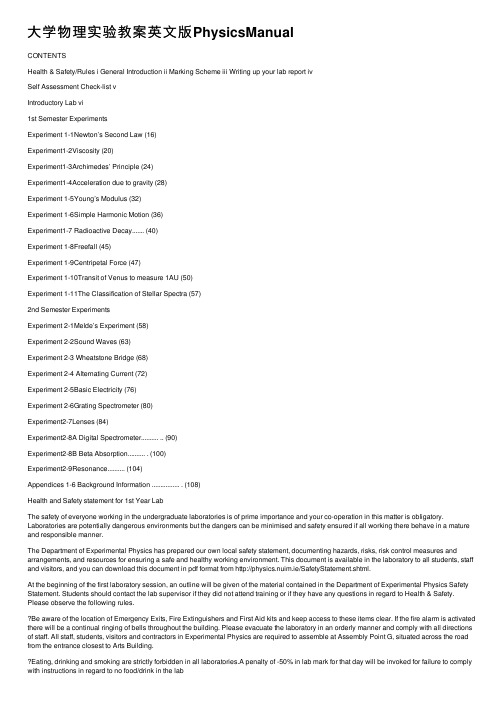
⼤学物理实验教案英⽂版PhysicsManualCONTENTSHealth & Safety/Rules i General Introduction ii Marking Scheme iii Writing up your lab report ivSelf Assessment Check-list vIntroductory Lab vi1st Semester ExperimentsExperiment 1-1Newton’s Second Law (16)Experiment1-2Viscosity (20)Experiment1-3Archimedes’ Principle (24)Experiment1-4Acceleration due to gravity (28)Experiment 1-5Young’s Modulus (32)Experiment 1-6Simple Harmonic Motion (36)Experiment1-7 Radioactive Decay (40)Experiment 1-8Freefall (45)Experiment 1-9Centripetal Force (47)Experiment 1-10Transit of Venus to measure 1AU (50)Experiment 1-11The Classification of Stellar Spectra (57)2nd Semester ExperimentsExperiment 2-1Melde’s Experiment (58)Experiment 2-2Sound Waves (63)Experiment 2-3 Wheatstone Bridge (68)Experiment 2-4 Alternating Current (72)Experiment 2-5Basic Electricity (76)Experiment 2-6Grating Spectrometer (80)Experiment2-7Lenses (84)Experiment2-8A Digital Spectrometer.......... .. (90)Experiment2-8B Beta Absorption.......... . (100)Experiment2-9Resonance (104)Appendices 1-6 Background Information ................ . (108)Health and Safety statement for 1st Year LabThe safety of everyone working in the undergraduate laboratories is of prime importance and your co-operation in this matter is obligatory. Laboratories are potentially dangerous environments but the dangers can be minimised and safety ensured if all working there behave in a mature and responsible manner.The Department of Experimental Physics has prepared our own local safety statement, documenting hazards, risks, risk control measures and arrangements, and resources for ensuring a safe and healthy working environment. This document is available in the laboratory to all students, staff and visitors, and you can download this document in pdf format from http://physics.nuim.ie/SafetyStatement.shtml.At the beginning of the first laboratory session, an outline will be given of the material contained in the Department of Experimental Physics Safety Statement. Students should contact the lab supervisor if they did not attend training or if they have any questions in regard to Health & Safety. Please observe the following rules.Be aware of the location of Emergency Exits, Fire Extinguishers and First Aid kits and keep access to these items clear. If the fire alarm is activated there will be a continual ringing of bells throughout the building. Please evacuate the laboratory in an orderly manner and comply with all directions of staff. All staff, students, visitors and contractors in Experimental Physics are required to assemble at Assembly Point G, situated across the road from the entrance closest to Arts Building.Eating, drinking and smoking are strictly forbidden in all laboratories.A penalty of -50% in lab mark for that day will be invoked for failure to comply with instructions in regard to no food/drink in the labAlways co-operate with staff on duty in the laboratory.All accidents, however trivial must be reported to a member of staff immediately who will inform the Head of Department. The University accident report form must be completed without delay and all persons must co operate with the University in any subsequent investigation.Please report any breakages, faulty equipment or any other hazards you may become aware of immediately to the demonstrator or any member of staff.Never use an item of equipment until you know how to operate it. If you are unsure, always ASK a member of staff.Turn off and disconnect electrical equipment from the mains or the 12 V supply when you are finished working. Always leave the apparatus and your workplace, in a safe and tidy condition before leaving the laboratory.Always wash your hands after laboratory work and before eating.Unsupervised work in the laboratories is forbidden. Undergraduate students have no access to laboratories except during scheduled practicals or tutorials.Do not run or play about in laboratories. Anyone not behaving in a mature and responsible manner will be asked to leave and may be excluded from the laboratory.Any student who shows persistent disregard for matters of safety is warned that this is a disciplinary offence, and the matter will be reported to the Laboratory Supervisor and Year Coordinator.Derek Gleeson (Safety Officer) Dept. of Exp Physics, September 2018Laboratory RulesAttendance is mandatory. If you cannot attend a laboratory session, you should notify the year course coordinator/Lab Supervisor — if possible in advance, otherwise as quickly as possible afterwards.You are not allowed to leave the laboratory without showing your final results and analysis to your demonstrator. At the end of the session you should leave your bench tidy for the next user. Switch off and disconnect all apparatus.If your partner is absent you have to do the experiment on your own or speak to demonstrator.Stick to assigned timetableStrictly no eating, drinking, or smoking in the laboratory, but you are allowed to takea brief break during the laboratory session. A penalty of -50% in lab mark for that daywill be invoked for failure to comply with instructions in regard to no food/drink in the labBags must be left at the wall close to the doors to avoid tripping hazard on the floor & to keep the benches clear.Ethical behaviourEvery student is expected and requiredto respect the rights of fellow students and the authority of the University academic and other staff in the performance of their dutiesto observe the rules and regulations of the Universityto conduct themselves in a manner conducive to the academic environment of the University and the promotion of its objectives.PlagiarismPlagiarism is the representation of another person’s work as one’s own, and includes unacknowledged use of material from books or periodicals, from the internet, from teachers and tutors, or from other students, without full acknowledgement of the sources.At all times, and in particular in relation to written reports and assignments, students are expected to comply with the statement on Plagiarism in the NUI Maynooth Calendar: https://www.maynoothuniversity.ie/sites/default/files/assets/document/Plagiarism%20Sept%202015_0.pdfFor the lab, your Continuous Assessment mark is based on your experimental report written in each lab session. Even though you work with a lab partner to carry out the experiment your report should be an independent piece of work written by you and should not be the same report your partner writes. Your conclusions/remarks on the experiment are required and should differ from your partner.GENERAL INTRODUCTIONThe purpose of a laboratory course is:To explore interesting and important physical phenomenato obtain an increased understanding of physical principlesto become familiar with laboratory instrumentsto acquire skill in the manipulation of apparatusto develop skills in observation and in the accurate recording and reporting of resultsExperimentation is the cornerstone of scientific knowledge. A full appreciation of many of the concepts you meet in lectures can only be achieved by exploring their consequences in laboratory experiments. This manual contains detailed instructions for carrying out each experiment; read the section on your next experiment before each session. Some students may have considerable experience of laboratory work, and will feel at home in the lab. In contrast, other students may not have any previous experience at all of doing their own experiments. Those students may find the first few weeks a learning curve: they may have some difficulty completing their experiments in the allotted time, or may find near the end of an experiment that they have misinterpreted the instructions etc. Remember that such ‘disasters’ do not necessarily mean a bad mark for that experiment. Every allowance will be made for initial inexperience and genuine oversight. No allowance will be made for attempts to cover up mistakes or failure to admit mistakes. If you pluck the “right answer” out of thin air you immediately arouse our suspicion. In fact, there is rarely a “right answer”,only well or badly executed experiments. You should make use of the laboratory demonstrators but do not rely on them totally - use your own brains to think your way out of a problem, and ask for help only when you cannot solve the problem yourself. Remember: the lab is a learning experience, not an examination.A good experimental outcome achieved through frequent recourse to the demonstrators will not merit a good mark - it is your contribution that is marked, not that of the demonstrators. Bear in mind that showing steady improvement during the year is the best sign that you are learning. You are not expected to do your experiments perfectly at the beginning of the year but you are expected to improve as the year passes. The appendices contain details on the preparation of a written report for each experiment. Additional information is included there on units and dimensions, graphs, errors and certain items of laboratory equipment.This is an opportunity for every student to obtain a significant continuous assessment mark before entering the examination hall at the end of the term. With diligent effort and steady work, every student should be able to do well in the laboratory.Dr. Neil Trappe First Year Course Director September 2018Writing Up Your Lab Report1. Preparation for each Practical Session(a) Read the laboratory manual and consult the recommended texts beforecoming to the laboratory. Make notes and bring those with you.2. Practical Report(a)The report should be prepared in an A4 hard-backed notebook with lined paperon one side and graph paper on the other supplied by the Department.(b)The report should be submitted on the Monday following the lab by 1pm in theassociated slot outside the first year laboratory(b) The record for each experiment should start on a fresh page. The followingtopics should be covered in the reportDate, Title, and Aim.Brief overview and context of the experiment and main related theory(Show you understand what ideas are being tested and how it is done and what you expect to show)Tables of Results - the results of your experiments should be recorded in ink immediately they are made. The laboratory manual suggests how the tablesof results might be laid out. Give yourself plenty of room in the layout.Clarity is very important. If you have cause to re-measure a certain quantity,record this fact below the table of results. Record the ‘experimentaluncertainties’ as you enter each item on the table.Any relevant graphs should be drawn on the graph paper in the notebook using pencil.Calculations - give the relevant formula and show how you arrived at your answer. Do not hold on to unjustifiable decimal places in your results. Usescientific notation e.g. write 7.43 10-3 instead of 0.00743.Error analysis is only required in 2nd term. Relevant calculations to estimate the accuracy of the experiment must be written in you laboratory notebook.Conclusions (not more than 100 words)-Summarise the aim and method of the experiment.State your main resultsComment on how your results compare with the expectedvalues and explain any discrepanciesSELF ASSESSMENT CHECK-LISTTo help you write a good report, the following questions try to guide you through the items you should include and also avoid common mistakes. Always write all data into your hardback note book not on your lab manual or on scraps of paper!1. Have you written the title and date of the experiment?2. Have you stated the aim of the experiment with a shortdescription of the procedure and apparatus used? (don’ttranscribe manual procedure, just summarise what you did briefly . (Most marks are for results/graphs/calculations and conclusions)3. Is your report written in a clear manner maybe with asimple clear diagram (if required)4. Have you written a good overview of the experiment?(Should be brief & concise)5. Your experimental results.Have you reported a full set of results? Yes No Are they presented clearly with correct units? Yes No Have you checked significant figures of results reported? Yes No5 Graphs (always on graph paper side of book) Do you need a graph to present data? Yes No Are the axes labelled and of correct scale? Yes No Have you drawn a best fit line? (see page 81 manual) Yes No Did you need to calculate a slope? Yes No6 Calculations Did you write down the formula you used? Yes NoDoes your calculation make physical sense – Think! Yes No Have you checked significant figures calculated? Yes NoHave you calculated what was asked for? Yes NoDoes the result seem sensible? Yes No7 Error analysis/UncertaintyHave you calculated error/uncertainty associated with experiment? Yes No Does this look reasonable? (Think of possible sources) Yes No8 Conclusions (100 words or so)Did you summarise the aim and method of experiment? Yes NoDid you state your main results Yes NoWas your experiment successful? Yes No Have you commented on accuracy of results? Yes No Have you stated discrepancies and possible sources of error? (less important in TERM I) Yes NoIntroductory Lab Experiment 1st Lab Session Reading Vernier scalesThe Vernier caliper is a precision instrument that can be used to measure internal and external distances extremely accurately. It is a very ingenious device for obtaining accuracy of a greater order than that obtainable by eye-estimation was invented by P. Vernier (1580 - 1637), and is known by his name. The example shown below is a manual caliper. Measurements are interpreted from the scale by the user. This is more difficult than using a digital Vernier caliper which has an LCD digital display on which the reading appears. The manual version has both an imperial and metric scale. How do we correctly read a Vernier scale? This is often an issue for 1st year students so let’s look at the method to read the Vernier scales and a few examples. The main scale works just like a ruler: the 0 mark on the vernier is compared to a main scale and the result is written down. Use the mark next to the zero, not the mark next to the edge of the vernier. Be sure to record the value of the main scale mark that is just to the left of the vernier zero mark.To take a reading:Look where the zero mark on the Vernier scale meets the main scale. This gives us our course reading, between 1.3 and 1.4cm (13 – 14 mm) in the example below.Now look to find the mark on the Vernier scale which most closely meets a mark on the main scale. In this example it is the 21st mark along (not counting the zero mark), which gives us our value for the most precise digit, in this case 0.42mm.The thickness is 13.42 mm in this example. Each small division of the Vernier scale is 0.02mmAnswer = ____________Answer = ____________Example:Main ScaleVernier ScaleReading A: 9 mmReading B: 0.26mmTotal: 9.26mmNotice that ‘B’ represents thirteen 0.02mm divisions on the vernier scale.Vernier circular scales (consider when required)The same concept can be applied to a circular scale. In the image below, the main outer scale is graduated in intervals of 30 minutes. Each interval on the vernier scale has an arc measure of 29 minutes. Again, count graduations up to the point at which a mark aligns with one on the lower scale. This will show the number of minutes to add to the direct reading.This scale is a bit more complex because the older-style instruments could read angles either right or left. There are two sets of numbers on the outside, stationary scale. The top numbers give the angle right, which is actually read to the left. This may be counterintuitive, but from this perspective the vernier moves to the left as the instrument turns to the right. There was a time (never to return) when I could read a one-minute scale without a magnifying glass. Verniers have also been used for a least-count precision of 30, 20, or 15 seconds. The scale is read with a magnifying glass, often attached to the instrument itself.The Micrometre Screw Gauge.The Micrometre Screw Gauge is an instrument which can measure accurately to ±0.001mm. However, it is limited to objects less than 25mm in size. This instrument also has a ‘vernier scale’.Close the micrometre fully using the ‘rachet stop’ (also known as the friction drive) to avoid over-tightening. Generally, the micrometre will not read zero and this ‘zero correction’ must be added to, or subtracted from the final reading as appropriate. Place the object to be measured between the ‘anvil’ and ‘spindle’. Tighten the micrometre using the ‘rachet stop’ (friction drive). An example is given below of how to read the micrometre. Adjust this reading for the ‘zero correction’.Read the barrel 8.500 mmRead the thimble 0.050 mmRead the vernier 0.008 mm8.558 mmIntroductory Lab Experiment Calculating DENSITY1. AimTo gain experience with Vernier scales in determining the densities of varioussubstances using samples of regular shape and a quick examination of the uncertainty in taking measurements in a lab. 2. TheoryREAD: Cutnell and Johnson - Chapter 11.1. The quantity of density is a measure of how much mass (“stuff”) is contained in a certain volume (length breath height) of a material. For example, Styrofoam would have a low density compared to a metal like gold or iron. Its formula is given by Density Mass in kg Volume in mkg /m 333. ProcedureThere are a number of example materials available in this lab to be analysed:-a rectangular block of wood (oak) an aluminium cylinder a steel ball bearing a brass welding rodEach sample should be weighted on the electronic balance - ‘zero’ the balance by pressing the appropriate button - select the relevant mass scale (200 grams for these samples) and place the sample on the pan. Determine the dimensions of the sample using either the Vernier calipers or the Micrometer Screw Gauge - the micrometer is the more accurate instrument but can only measure up to 25 mm (0.25 10-1 m).See the appendices for details on how to use these instruments. Calculate the volume using one of the formulae:-Rectangular shape - Length Breadth HeightCylindrical shape - (Diameter) Height4Spherical shape -Diameter 2 36Fill out the various rows in the table below which apply to your sample under study. Calculate the various densities for the materials you use.4. Error Analysis (for you information at this stage)Before we go into details of error analysis later in the term it is important to understand the meaning of errors in physics. Error in a scientific measurement does not mean a mistake or blunder. Instead, the terms "error" and "uncertainty" both refer to unavoidable imprecision inmeasurements – the inherent small uncertainty that exists when taking measurements.Density ()Mass () Volume ()M VThe % error in density ( %) is related to the % errors in mass ( M %) and volume ( V %) as follows:-% = M % + V %M %.0011010013Mass in kg The electronic balance on the ‘200gram’ scale is accurate to 001103. kg.V % depends on the shape - using L for length, B for breadth, H for height and D for diameter, calculate V % as follows:-RectangularV L B H %%%% Cylindrical V H D %%% 2 SphericalV D %% 3L0021010013.Length in metres Similarly for B and H (measured with the Vernier calipers whose accuracyis 0022105. mm or m).D 00011010013.Diameter in metresThe Micrometer Screw Gauge is accurate to 0001106. mm (m). Note that the % error in D , the diameter, is doubled for a cylinder and tripled for a sphere.EXPERIMENT 1 – 1 NEWTON’S SECOND LAW____________________________________________________________________ 1.Aim- To verify Newton’s Second Law of Motion.2.TheoryREAD: Cutnell and Johnson – Chapter 4.3When a net external force F is applied to an object of mass m, the acceleration a that results is directly proportional to the net force and has a magnitude that is inversely proportional to the mass. The direction of the acceleration is the same as the direction of the net force. F and a are vector quantities, while m is a scalar quantity.F = m aF is measured in newtons (N), a is measured in metres per second squared (m/s2) and m is measured in kilograms (kg).3.Procedure4. Experimental MethodThe air-track arrangement is similar to that shown above. Unhook the Mass Holder from the Glider and level the track carefully using the adjustable feet. With the air-blower turned on, the Glider will sit on a level track without moving in either direction. Transfer 100 grams from the weight box onto the Mass Holder. Record the mass of the Mass Holder and the added mass as m a. The gravitational force due to m a causes the gilder to be accelerated. This acceleration can be measured electronically using the Smart Timer.Turn on the Smart Timer with the photogate connected to plug 1 on the Smart Timer. Set the Smart Timer to acceleration and to linear pulley. Pressing the start/stop button will make a star appear on the screen. This star indicates that the timer is ready for a measurement to be made.Pull the Glider approximately 90cm from the pulley allowing the mass holder to hang up to about 30cm below the pulley. Turn on the air supply. When the Glider is in place with the air supply on, the start/stop button can be pressed and the Glider released. Press the Start/Stop button such that the star appears and simultaneously release the glider so that it runs the track for an accurate result.Record the figure on the screen of the Smart Timer as the acceleration in cm/s2 due to the combined mass of the 100 g mass and the Mass Holder. Repeat this measurement five times until a consistent set of results is obtained, making sure that the Total Mass of the system remains constant.The Glider does not need to travel the length of the whole track to take the reading and should be stopped manually once a figure appears on the screen and before hitting the damper at the pulley.(Ensure that the laser photogate is accurately being interrupted by the spokes of the wheel pulley by observing the blinking red LED as the glider travels the system)The table below should be copied into your lab notebook and used to record your results. The value of the acceleration due to gravity is g = 9.81m/s2Weigh the Mass Holder, the Glider and the added masses and record this as M T., the total mass of the system.5. Experimental Results:Mass transferred from the Glider to the Mass HolderRunnumber100 grams 90 grams 80 grams 70 grams 60 grams 50 grams1.2.3.averageTransfer another 10 g from the Mass Holder to the Glider and repeat the measurements taken above. Continue to transfer 10 g masses from the Mass Holder to the Glider untilyou have measured the average acceleration caused by having a 100, 90, 80, 70, 60, 50 gon the Mass Holder.M T – Total system mass = ________ (kg)Total mass of Mass Holder & added masses –m a (kg) Average acceleration causedby the total mass recorded incolumn 1.a (m/s2)Gravitational force due tototal mass recorded incolumn 1 .F a = m a × 9.81 N(This is the ‘applied force’referred to below.)6. Calculations:Draw a graph of the applied force, F a , versus the average acceleration a of the whole system (Glider plus added masses plus Mass Holder), i.e. plot F a on the y axis and a on the x axis.Since Newton’s Second Law states that the acceleration is proportional to the applied force, i.e., F = m a, your data points should lie on a straight line.Measure the slope of your graph and compare your measured slope to the expected value, which is the total mass of the system, M T.7. ConclusionsIn no more than 100 words write a succinct summary of what you have done. State the goal and method of the experiment. State your main results, i.e., Did you find that the acceleration is proportional to the applied force, or not? What value did you get for the constant of proportionality ? Are your results consistent with Newton’s Second Law? If your results are not consistent with Newton’s Second Law, can you suggest why not?8. Sample ConclusionsA horizontal air track apparatus was used to measure the acceleration of a mass of450grams in response to an applied force. The applied force was due to gravity acting on part of the 450 grams. We have found that the acceleration of the mass is indeed proportional to the applied force and that the slope of a graph of force versus acceleration gave a straight line with slope 0.440 kg. This is close to the expected value of 450 grams, and in reasonable agreement with Newton’s Second Law.。
大学物理教案英文版简谐振动Simple harmonic oscillation
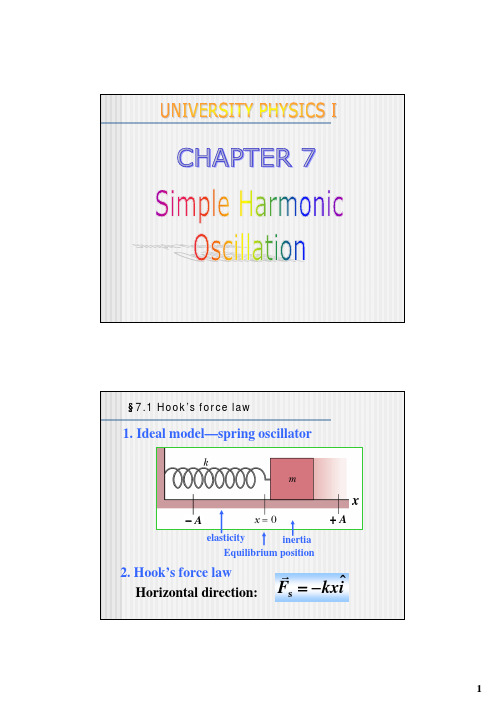
+A +A
+ ωA − ωA
+ω2 A +ω2 A
φ=0
d 2 x( t ) a( t ) = dt 2 = − Aω 2 cos(ωt + φ )
x = + xm v = 0 a = −am x = 0 v = −v m a = 0 x = − xm v = 0 a = +am
§7.2 Simple harmonic oscillation
r A
ϕ
ω
r A1
ω
x
x 1 = A1 cos( ω t + ϕ 1 )
x 2 = A2 cos( ω t + ϕ 2 )
ϕ2
ϕ1
x = x1 + x 2
x2
x1
x
r r r A = A1 + A 2
= A cos( ω t + ϕ )
A=
2 A12 + A2 + 2 A1 A2 cos(ϕ 2 − ϕ 1 ) A1 sinϕ1 + A2 sinϕ 2 ϕ = arctg A1 cosϕ1 + A2 cosϕ 2
§7.4 simple harmonic motion and the uniform circular motion
ωA
A
x ( t ) = A cos(ωt + φ )
v ( t ) = − Aω sin(ωt + φ )
9
§7.4 simple harmonic motion and the uniform circular motion
1
§7.2 Simple harmonic oscillation
大学物理 英文版 第一章
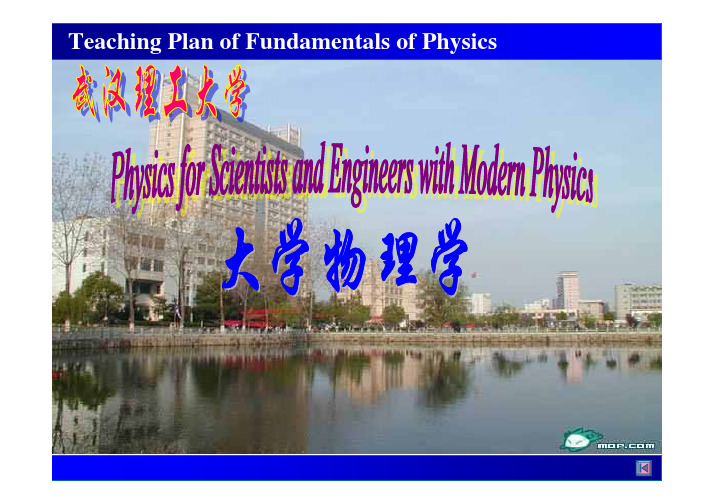
Teaching Plan of Fundamentals of PhysicsTeaching Plan of Fundamentals of Physics 考核办法: 1. 平时成绩(20分) • 作业 • 2. 出勤 (70%)(学委负责制) (30%)(班长负责制)考试成绩(80分):考试内容:课堂讲的例题,课后作业(70~80%)Teaching Plan of Fundamentals of PhysicsTeaching Plan of Fundamentals of PhysicsReference Books:1.《 Fundamentals of Physics 》 6th Edition, Halliday 2 《 大学物理 》第四版 马文尉 主编 3.《 大学物理 》第二版 张三慧 主编 4.《 大学物理 》第一版 廖耀发 主编Teaching Plan of Fundamentals of PhysicsI The Contents of PhysicsClassical physicsIntroductionMotion, fluids, heat, sound, light, electricity, magnetism Relativity, atomic structure, condensed matter, nuclear physics, elementary particles, astrophysicsIt deals with the behavior and structure of the matter.Modern physicsII Why to Learn Physics1 It’s interesting 2 It’s usefulTeaching Plan of Fundamentals of PhysicsMufanba PhenomenarefrigeratoryTeaching Plan of Fundamentals of PhysicsTeaching Plan of Fundamentals of PhysicsTeaching Plan of Fundamentals of PhysicsTeaching Plan of Fundamentals of PhysicsTeaching Plan of Fundamentals of Physics 强磁场强磁场的作用是改变一个系统的物理状态,即改变角动量(自旋) 和带电粒子的轨道运动,并破坏时间反演对称性,使它们具有更独特的 性质, 因此,也就改变了物理系统的状态. 1 “黑洞”原来是超强磁场.天体物理学家发现 “磁场吸积”计算机 模型预言的“磁风” 与“钱德拉”X射线观测 望远镜拍摄银河中心黑洞GRO J655-40 的X射 线光谱中特殊的峰值相对应.2韩国科学家称在强磁场下水20摄氏度就能 结冰. 3磁化处理可提高水玻璃的粘结强度,使之最大可达50%; 4强流脉冲离子束使金属表面发生细晶强化,加工硬化和相变强化,提 高金属表面硬度,改善奈磨性.Teaching Plan of Fundamentals of Physics 超低温1 超导态是一些物质在超低温下出现的特殊物态。
《大学物理AII》作业 No.11 热力学第一定律(参考答案)
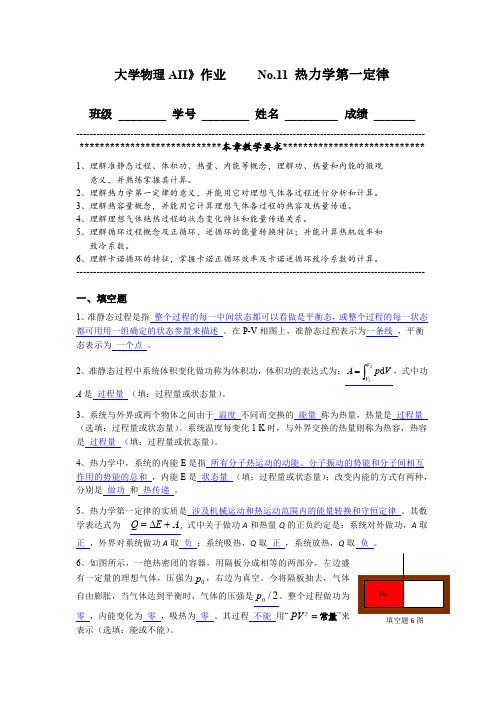
V2
V1
ò p d V 来直接求解做功,但可以
答: (1)不可能。等容加热过程中,系统吸热且不对外做功,根据热力学第一定律其内能一 定增加。 (2)不可能。等温压缩过程中,系统内能不变,对外做负功,根据热力学第一定律系统一 定是经历放热过程。 (3)不可能。等压压缩过程中,系统温度降低,内能减少,同时对外做负功,根据热力学 第一定律系统一定是经历放热过程。 (4)可能。绝热压缩过程,吸热为零,外界对系统做功,系统内能一定增加。
氢气是双原子分子,其自由度为 5,而氦气是单原子分子,其自由度为 3,因此氢气与氦气
5 RT 2 ,所以 3 2 E2 = m RT 4 2 E1 =
m1 2
的内能分别为:
E1 = 5/ 3 E2 ;
7 R 2 ,当它们吸收相同的热量,意味着它们的温度变 5 = R 2
氢气与氦气的等压热容分别为:
Aab = 0
b—c 等压过程: Qbc =
m i+2 3 CP (Tc - Tb ) = ( PcVc - PbVb ) = (i + 2) P 1V1 M 2 8
Abc =
1 3 P1 ( Vc - Vb ) = P1V1 4 4
m V 1 RTa ln A = PaVa ln = - P 1V1ln 4 M VC 4
大学物理英文版

§1-1 Frame of Reference Particle(质点)
1. Frame of Reference(参照系)
•张达宋 《物理学基本教程》 •李行一等, 《物理学基本教程教学参考书》 •李行一等,《物理学基本教程》习题分析与解答 •张三慧等, 《大学物理学》 •Halliday et.al 《Fundamentals of Physics》 •W. Sears et.al 《University Physics》 •史蒂芬.霍金,《时间简史》 •盛正卯等,《物理学与人类文明》 •B.K.里德雷,《时间、空间和万物》 •…………..
4.Units(单位)
International System of Units(SI: Syst me International d’Unit s 法语) is used in China
mass
m
kg:千克 kilogram
length
L m:米 meter
Time
t s:秒 second
5. Scalar and vector(标量和矢量): Two types of physical quantities(量):
教 学基本 要 求
1. 理解描述质点运动物理量的定义及其矢量性、相 对性和瞬时性; 2. 掌握运动方程的物理意义,会用微积分方法求解 运动学两类问题; 3. 掌握平面抛体运动和圆周运动的规律; 4. 理解运动描述的相对性,会用速度合成定理和加 速度合成定理解题。
重要历史人物
(完整版)大学物理(力学)试卷附答案
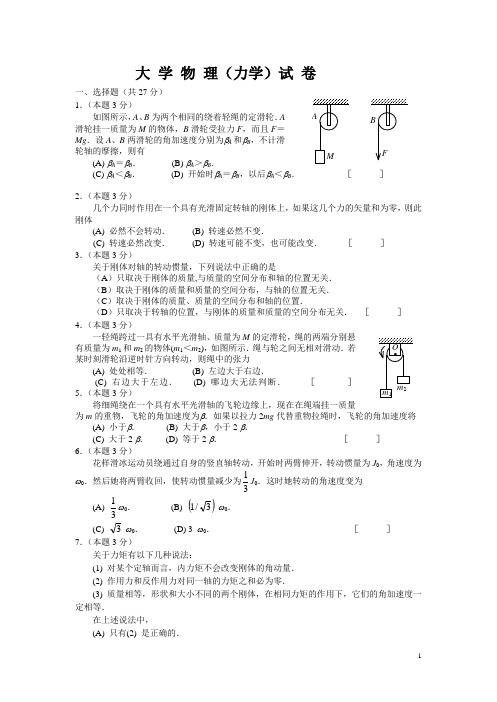
大 学 物 理(力学)试 卷一、选择题(共27分) 1.(本题3分)如图所示,A 、B 为两个相同的绕着轻绳的定滑轮.A 滑轮挂一质量为M 的物体,B 滑轮受拉力F ,而且F =Mg .设A 、B 两滑轮的角加速度分别为βA 和βB ,不计滑轮轴的摩擦,则有 (A) βA =βB . (B) βA >βB .(C) βA <βB . (D) 开始时βA =βB ,以后βA <βB . [ ] 2.(本题3分)几个力同时作用在一个具有光滑固定转轴的刚体上,如果这几个力的矢量和为零,则此刚体(A) 必然不会转动. (B) 转速必然不变.(C) 转速必然改变. (D) 转速可能不变,也可能改变. [ ] 3.(本题3分)关于刚体对轴的转动惯量,下列说法中正确的是 (A )只取决于刚体的质量,与质量的空间分布和轴的位置无关. (B )取决于刚体的质量和质量的空间分布,与轴的位置无关. (C )取决于刚体的质量、质量的空间分布和轴的位置.(D )只取决于转轴的位置,与刚体的质量和质量的空间分布无关. [ ] 4.(本题3分)一轻绳跨过一具有水平光滑轴、质量为M 的定滑轮,绳的两端分别悬有质量为m 1和m 2的物体(m 1<m 2),如图所示.绳与轮之间无相对滑动.若某时刻滑轮沿逆时针方向转动,则绳中的张力 (A) 处处相等. (B) 左边大于右边.(C) 右边大于左边. (D) 哪边大无法判断. [ ]5.(本题3分)将细绳绕在一个具有水平光滑轴的飞轮边缘上,现在在绳端挂一质量为m 的重物,飞轮的角加速度为β.如果以拉力2mg 代替重物拉绳时,飞轮的角加速度将 (A) 小于β. (B) 大于β,小于2 β.(C) 大于2 β. (D) 等于2 β. [ ] 6.(本题3分)花样滑冰运动员绕通过自身的竖直轴转动,开始时两臂伸开,转动惯量为J 0,角速度为ω0.然后她将两臂收回,使转动惯量减少为31J 0.这时她转动的角速度变为(A)31ω0. (B) ()3/1 ω0. (C) 3 ω0. (D) 3 ω0. [ ]7.(本题3分)关于力矩有以下几种说法:(1) 对某个定轴而言,内力矩不会改变刚体的角动量. (2) 作用力和反作用力对同一轴的力矩之和必为零.(3) 质量相等,形状和大小不同的两个刚体,在相同力矩的作用下,它们的角加速度一定相等.在上述说法中,(A) 只有(2) 是正确的.(B) (1) 、(2) 是正确的. (C) (2) 、(3) 是正确的.(D) (1) 、(2) 、(3)都是正确的. [ ] 8.(本题3分)一圆盘正绕垂直于盘面的水平光滑固定轴O 转动,如图射来两个质量相同,速度大小相同,方向相反并在一条直线上的子弹,子弹射入圆盘并且留在盘内,则子弹射入后的瞬间,圆盘的角速度ω (A) 增大. (B) 不变.(C) 减小. (D) 不能确定. [ ] 9.(本题3分)质量为m 的小孩站在半径为R 的水平平台边缘上.平台可以绕通过其中心的竖直光滑固定轴自由转动,转动惯量为J .平台和小孩开始时均静止.当小孩突然以相对于地面为v的速率在台边缘沿逆时针转向走动时,则此平台相对地面旋转的角速度和旋转方向分别为(A) ⎪⎭⎫⎝⎛=R JmR v 2ω,顺时针. (B) ⎪⎭⎫ ⎝⎛=R J mR v 2ω,逆时针. (C) ⎪⎭⎫ ⎝⎛+=R mR J mR v 22ω,顺时针. (D) ⎪⎭⎫⎝⎛+=R mR J mR v 22ω,逆时针. [ ]二、填空题(共25分)10.(本题3分)半径为20 cm 的主动轮,通过皮带拖动半径为50 cm 的被动轮转动,皮带与轮之间无相对滑动.主动轮从静止开始作匀角加速转动.在4 s 内被动轮的角速度达到8πrad ·s -1,则主动轮在这段时间内转过了________圈. 11.(本题5分)绕定轴转动的飞轮均匀地减速,t =0时角速度为ω 0=5 rad / s ,t =20 s 时角速度为ω = 0.8ω 0,则飞轮的角加速度β =______________,t =0到 t =100 s 时间内飞轮所转过的角度θ =___________________. 12.(本题4分)半径为30 cm 的飞轮,从静止开始以0.50 rad ·s -2的匀角加速度转动,则飞轮边缘上一点在飞轮转过240°时的切向加速度a t =________,法向加速度a n =_______________. 13.(本题3分)一个作定轴转动的物体,对转轴的转动惯量为J .正以角速度ω0=10 rad ·s -1匀速转动.现对物体加一恒定制动力矩 M =-0.5 N ·m ,经过时间t =5.0 s 后,物体停止了转动.物体的转动惯量J =__________. 14.(本题3分)一飞轮以600 rev/min 的转速旋转,转动惯量为2.5 kg ·m 2,现加一恒定的制动力矩使飞轮在1 s 内停止转动,则该恒定制动力矩的大小M =_________. 15.(本题3分)质量为m 、长为l 的棒,可绕通过棒中心且与棒垂直的竖直光滑固定轴O 在水平面内自由转动(转动惯量J =m l 2 / 12).开始时棒静止,现有一子弹,质量也是m ,在水平面内以速度v 0垂直射入棒端并嵌在其中.则子弹嵌入后棒的角速度ω =_____________________. 16.(本题4分)在一水平放置的质量为m 、长度为l 的均匀细杆上,套着一质量也为m 的套管B (可看作质点),套管用细线拉住,它到竖直的光滑固定轴OO '的距离为l 21,杆和套管所组成的系统以角速度ω0绕OO '轴转动,如图所示.若在转动过程中细线被拉断,套管将沿着杆滑动.在套管滑动过程中,该系统转动的角速度ωmm m0v 俯视图与套管离轴的距离x 的函数关系为_______________.(已知杆本身对OO '轴的转动惯量为231ml )三、计算题(共38分) 17.(本题5分)如图所示,一圆盘绕通过其中心且垂直于盘面的转轴,以角速度ω作定轴转动,A 、B 、C 三点与中心的距离均为r .试求图示A 点和B 点以及A 点和C 点的速度之差B A v v ϖϖ-和C A v v ϖϖ-.如果该圆盘只是单纯地平动,则上述的速度之差应该如何? 18.(本题5分)一转动惯量为J 的圆盘绕一固定轴转动,起初角速度为ω0.设它所受阻力矩与转动角速度成正比,即M =-k ω (k 为正的常数),求圆盘的角速度从ω0变为021ω时所需的时间.19.(本题10分)一轻绳跨过两个质量均为m 、半径均为r 的均匀圆盘状定滑轮,绳的两端分别挂着质量为m 和2m 的重物,如图所示.绳与滑轮间无相对滑动,滑轮轴光滑.两个定滑轮的转动惯量均为221mr .将由两个定滑轮以及质量为m 和2m 的重物组成的系统从静止释放,求两滑轮之间绳内的张力.20.(本题8分)如图所示,A 和B 两飞轮的轴杆在同一中心线上,设两轮的转动惯量分别为 J =10 kg ·m 2 和 J =20 kg ·m 2.开始时,A 轮转速为600 rev/min ,B 轮静止.C 为摩擦啮合器,其转动惯量可忽略不计.A 、B 分别与C 的左、右两个组件相连,当C 的左右组件啮合时,B 轮得到加速而A 轮减速,直到两轮的转速相等为止.设轴光滑,求:(1) 两轮啮合后的转速n ;(2) 两轮各自所受的冲量矩.21.(本题10分)空心圆环可绕光滑的竖直固定轴AC 自由转动,转动惯量为J 0,环的半径为R ,初始时环的角速度为ω0.质量为m 的小球静止在环内最高处A 点,由于某种微小干扰,小球沿环向下滑动,问小球滑到与环心O 在同一高度的B 点和环的最低处的C 点时,环的角速度及小球相对于环的速度各为多大?(设环的内壁和小球都是光滑的,小球可视为质点,环截面半径r <<R .) 回答问题(共10分) 22.(本题5分)绕固定轴作匀变速转动的刚体,其上各点都绕转轴作圆周运动.试问刚体上任意一点是否有切向加速度?是否有法向加速度?切向加速度和法向加速度的大小是否变化?理由如何? 23.(本题5分)一个有竖直光滑固定轴的水平转台.人站立在转台上,身体的中心轴线与转台竖直轴线重合,两臂伸开各举着一个哑铃.当转台转动时,此人把两哑铃水平地收缩到胸前.在这一收缩过程中,(1) 转台、人与哑铃以及地球组成的系统机械能守恒否?为什么? (2) 转台、人与哑铃组成的系统角动量守恒否?为什么?(3) 每个哑铃的动量与动能守恒否?为什么?大 学 物 理(力学) 试 卷 解 答一、选择题(共27分)C D C C C D B C A 二、填空题(共25分) 10.(本题3分)20 参考解: r 1ω1=r 2ω2 , β1 = ω1 / t 1 ,θ1=21121t β 21211412ωθr r n π=π=4825411⨯π⨯⨯π=t =20 rev11.(本题5分)-0.05 rad ·s -2 (3分)250 rad (2分)12.(本题4分)0.15 m ·s -2(2分)1.26 m ·s -2(2分)参考解: a t =R ·β =0.15 m/s 2 a n =R ω 2=R ·2βθ =1.26 m/s 2 13.(本题3分)0.25 kg ·m 2(3分) 14.(本题3分)157N·m (3分) 15.(本题3分)3v 0/(2l )16.(本题4分)()2202347xl l +ω三、计算题(共38分) 17.(本题5分)解:由线速度r ϖϖϖ⨯=ωv 得A 、B 、C 三点的线速度ωr C B A ===v v v ϖϖϖ 1分各自的方向见图.那么,在该瞬时 ωr A B A 22==-v v v ϖϖϖθ=45° 2分同时 ωr A C A 22==-v v v ϖϖϖ方向同A v ϖ. 1分平动时刚体上各点的速度的数值、方向均相同,故0=-=-C A B A v v v v ϖϖϖϖ 1分 [注]此题可不要求叉积公式,能分别求出 A v ϖ、B v ϖ的大小,画出其方向即可. 18.(本题5分)解:根据转动定律: J d ω / d t = -k ω∴t Jkd d -=ωω2分 两边积分:⎰⎰-=t t Jk 02/d d 100ωωωω得 ln2 = kt / J∴ t =(J ln2) / k 3分19.(本题10分)θ BC AωB v ϖC v ϖA v ϖB v ϖ-A v ϖB v v A ϖϖ- -C v ϖ A v ϖ解:受力分析如图所示. 2分 2mg -T 1=2ma 1分 T 2-mg =ma 1分T 1 r -T r =β221mr 1分T r -T 2 r =β221mr 1分a =r β2分解上述5个联立方程得: T =11mg / 8 2分20.(本题8分)解:(1) 选择A 、B 两轮为系统,啮合过程中只有内力矩作用,故系统角动量守恒1分 J A ωA +J B ωB = (J A +J B )ω, 2分 又ωB =0得 ω ≈ J A ωA / (J A +J B ) = 20.9 rad / s 转速 ≈n 200 rev/min 1分(2) A 轮受的冲量矩⎰t MAd = J A (ω -ωA ) = -4.19×10 2 N ·m ·s 2分负号表示与A ωϖ方向相反. B 轮受的冲量矩⎰t MBd = J B (ω - 0) = 4.19×102 N ·m ·s 2分方向与A ωϖ相同.21.(本题10分)解:选小球和环为系统.运动过程中所受合外力矩为零,角动量守恒.对地球、小球和环系统机械能守恒.取过环心的水平面为势能零点.两个守恒及势能零点各1分,共3分小球到B 点时: J 0ω0=(J 0+mR 2)ω ① 1分()22220200212121BR m J mgR J v ++=+ωωω ② 2分 式中v B 表示小球在B 点时相对于地面的竖直分速度,也等于它相对于环的速度.由式①得:ω=J 0ω 0 / (J 0 + mR 2) 1分代入式②得222002J mR RJ gR B ++=ωv 1分 当小球滑到C 点时,由角动量守恒定律,系统的角速度又回复至ω0,又由机械能守恒定律知,小球在C 的动能完全由重力势能转换而来.即:()R mg m C 2212=v , gR C 4=v 2分四、问答题(共10分) 22.(本题5分)答:设刚体上任一点到转轴的距离为r ,刚体转动的角速度为ω,角加速度为β,则由运动学关系有:切向加速度a t =r β 1分 法向加速度a n =r ω2 1分对匀变速转动的刚体来说β=d ω / d t =常量≠0,因此d ω=βd t ≠0,ω 随时间变化,即ω=ω (t ). 1分所以,刚体上的任意一点,只要它不在转轴上(r ≠0),就一定具有切向加速度和法向加速度.前者大小不变,后者大小随时间改变. 2分(未指出r ≠0的条件可不扣分)m 2m βT 2 2P ϖ1P ϖTa T 1a23.(本题5分)答:(1) 转台、人、哑铃、地球系统的机械能不守恒. 1分因人收回二臂时要作功,即非保守内力的功不为零,不满足守恒条件. 1分 (2) 转台、人、哑铃系统的角动量守恒.因系统受的对竖直轴的外力矩为零. 1分(3) 哑铃的动量不守恒,因为有外力作用. 1分 哑铃的动能不守恒,因外力对它做功. 1分 刚体题一 选择题 1.(本题3分,答案:C ;09B )一轻绳跨过一具有水平光滑轴、质量为M 的定滑轮,绳的两端分别悬有质量为m 1和m 2的物体(m 1<m 2),如图所示.绳与轮之间无相对滑动.若某时刻滑轮沿逆时针方向转动,则绳中的张力 (A) 处处相等. (B) 左边大于右边.(C) 右边大于左边. (D) 哪边大无法判断. 2.(本题3分,答案:D ;09A ) 花样滑冰运动员绕通过自身的竖直轴转动,开始时两臂伸开,转动惯量为J 0,角速度为ω0.然后她将两臂收回,使转动惯量减少为31J 0.这时她转动的角速度变为(A)31ω0. (B) ()3/1 ω0. (C)3 ω0. (D) 3 ω0.3.( 本题3分,答案:A ,08A )1.均匀细棒OA 可绕通过其一端O 而与棒垂直的水平固定光滑轴转动,如图所示,今使棒从水平位置由静止开始自由下落,在棒摆动到竖立位置的过程中,下述说法哪一种是正确的?(A) 角速度从小到大,角加速度从大到小. (B) 角速度从小到大,角加速度从小到大. (C) 角速度从大到小,角加速度从大到小.(D) 角速度从大到小,角加速度从小到大. 二、填空题1(本题4分,08A, 09B )一飞轮作匀减速运动,在5s 内角速度由40πrad/s 减少到10π rad/s ,则飞轮在这5s 内总共转过了 圈,飞轮再经 的时间才能停止转动。
大学物理实验报告 英文版
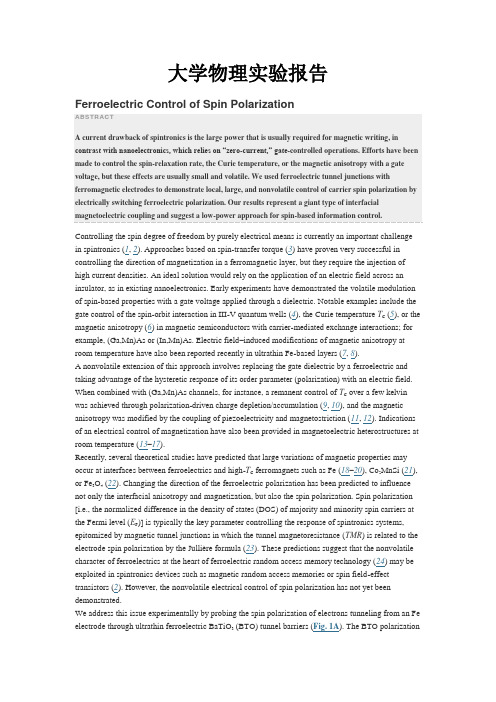
大学物理实验报告Ferroelectric Control of Spin PolarizationABS TR AC TA current drawback of spintronics is the large power that is usually required for magnetic writing, in contrast with nanoelectronics, which relies on “zero-current,” gate-controlled operations. Efforts have been made to control the spin-relaxation rate, the Curie temperature, or the magnetic anisotropy with a gate voltage, but these effects are usually small and volatile. We used ferroelectric tunnel junctions with ferromagnetic electrodes to demonstrate local, large, and nonvolatile control of carrier spin polarization by electrically switching ferroelectric polarization. Our results represent a giant type of interfacial magnetoelectric coupling and suggest a low-power approach for spin-based information control.Controlling the spin degree of freedom by purely electrical means is currently an important challenge in spintronics (1, 2). Approaches based on spin-transfer torque (3) have proven very successful in controlling the direction of magnetization in a ferromagnetic layer, but they require the injection of high current densities. An ideal solution would rely on the application of an electric field across an insulator, as in existing nanoelectronics. Early experiments have demonstrated the volatile modulation of spin-based properties with a gate voltage applied through a dielectric. Notable examples include the gate control of the spin-orbit interaction in III-V quantum wells (4), the Curie temperature T C (5), or the magnetic anisotropy (6) in magnetic semiconductors with carrier-mediated exchange interactions; for example, (Ga,Mn)As or (In,Mn)As. Electric field–induced modifications of magnetic anisotropy at room temperature have also been reported recently in ultrathin Fe-based layers (7, 8).A nonvolatile extension of this approach involves replacing the gate dielectric by a ferroelectric and taking advantage of the hysteretic response of its order parameter (polarization) with an electric field. When combined with (Ga,Mn)As channels, for instance, a remanent control of T C over a few kelvin was achieved through polarization-driven charge depletion/accumulation (9, 10), and the magnetic anisotropy was modified by the coupling of piezoelectricity and magnetostriction (11, 12). Indications of an electrical control of magnetization have also been provided in magnetoelectric heterostructures at room temperature (13–17).Recently, several theoretical studies have predicted that large variations of magnetic properties may occur at interfaces between ferroelectrics and high-T C ferromagnets such as Fe (18–20), Co2MnSi (21), or Fe3O4 (22). Changing the direction of the ferroelectric polarization has been predicted to influence not only the interfacial anisotropy and magnetization, but also the spin polarization. Spin polarization [i.e., the normalized difference in the density of states (DOS) of majority and minority spin carriers at the Fermi level (E F)] is typically the key parameter controlling the response of spintronics systems, epitomized by magnetic tunnel junctions in which the tunnel magnetoresistance (TMR) is related to the electrode spin polarization by the Jullière formula (23). These predictions suggest that the nonvolatile character of ferroelectrics at the heart of ferroelectric random access memory technology (24) may be exploited in spintronics devices such as magnetic random access memories or spin field-effect transistors (2). However, the nonvolatile electrical control of spin polarization has not yet been demonstrated.We address thi s issue experimentally by probing the spin polarization of electrons tunneling from an Fe electrode through ultrathin ferroelectric BaTiO3 (BTO) tunnel barriers (Fig. 1A). The BTO polarizationcan be electrically switched to point toward or away from the Fe electrode. We used a half-metallicLa0.67Sr0.33MnO3(LSMO) (25) bottom electrode as a spin detector in these artificial multiferroic tunnel junctions (26, 27). Magnetotransport experiments provide evidence for a large and reversible dependence of the TMR on ferroelectric polarization direction.Fig. 1(A) Sketch of the nanojunction defined by electrically controlled nanoindentation. A thin resist isspin-coated on the BTO(1 nm)/LSMO(30 nm) bilayer. The nanoindentation is performed with a conductive-tip atomic force microscope, and the resulting nano-hole is filled by sputter-depositingAu/CoO/Co/Fe. (B) (Top) PFM phase image of a BTO(1 nm)/LSMO(30 nm) bilayer after poling the BTO along 1-by-4–μm stripes with either a negative or positive (tip-LSMO) voltage. (Bottom) CTAFM image of an unpoled area of a BTO(1 nm)/LSMO(30 nm) bilayer. Ω, ohms. (C) X-ray absorption spectra collected at room temperature close to the Fe L3,2 (top), Ba M5,4 (middle), and TiL3,2 (bottom) edges on an AlO x(1.5 nm)/Al(1.5 nm)/Fe(2 nm)/BTO(1 nm)/LSMO(30 nm)//NGO(001) heterostructure. (D) HRTEM and (E) HAADF images of the Fe/BTO interface in a Ta(5 nm)/Fe(18 nm)/BTO(50 nm)/LSMO(30 nm)//NGO(001) heterostructure. The white arrowheads in (D) indicate the lattice fringes of {011} planes in the iron layer. [110] and [001] indicate pseudotetragonal crystallographic axes of the BTO perovskite.The tunnel junctions that we used in this study are based on BTO(1 nm)/LSMO(30 nm) bilayers grown epitaxially onto (001)-oriented NdGaO3 (NGO) single-crystal substrates (28). The large (~180°) and stable piezoresponse force microscopy (PFM) phase contrast (28) between negatively and positively poled areas (Fig. 1B, top) indicates that the ultrathin BTO films are ferroelectric at room temperature (29). The persistence of ferroelectricity for such ultrathin films of BTO arises from the large latticemis match with the NGO substrate (–3.2%), which is expected to dramatically enhance ferroelectric properties in this highly strained BTO (30). The local topographical and transport properties of the BTO(1 nm)/LSMO(30 nm) bilayers were characterized by conductive-tip atomic force microscopy (CTA FM) (28). The surface is very smooth with terraces separated by one-unit-cell–high steps, visible in both the topography (29) and resistance mappings (Fig. 1B, bottom). No anomalies in the CTAFM data were observed over lateral distances on the micrometer scale.We defined tunnel junctions from these bilayers by a lithographic technique based on CTAFM (28, 31). Top electrical contacts of diameter ~10 to 30 nm can be patterned by this nanofabrication process. The subsequent sputter deposition of a 5-nm-thick Fe layer, capped by a Au(100 nm)/CoO(3.5 nm)/Co(11.5 nm) stack to increase coercivity, defined a set of nanojunctions (Fig. 1A). The same Au/CoO/Co/Fe stack was deposited on another BTO(1 nm)/LSMO(30 nm) sample for magnetic measurements. Additionally, a Ta(5 nm)/Fe(18 nm)/BTO(50 nm)/LSMO(30 nm) sample and a AlO x(1.5 nm)/Al(1.5 nm)/Fe(2 nm)/BTO(1 nm)/LSMO(30 nm) sample were realized for structural and spectroscopic characterizations.We used both a conventional high-resolution transmission electron microscope (HRTEM) and the NION UltraSTEM 100 scanning transmission electron microscope (STEM) to investigate the Fe/BTO interface properties of the Ta/Fe/BTO/LSMO sample. The epitaxial growth of the BTO/LSMO bilayer on the NGO substrate was confirmed by HRTEM and high-resolution STEM images. Thelow-resolution, high-angle annular dark field (HAADF) image of the entire heterostructure shows the sharpness of the LSMO/BTO interface over the studied area (Fig. 1E, top). Figure 1D reveals a smooth interface between the BTO and the Fe layers. Whereas the BTO film is epitaxially grown on top of LSMO, the Fe layer consists of textured nanocrystallites. From the in-plane (a) and out-of-plane (c) lattice parameters in the tetragonal BTO layer, we infer that c/a = 1.016 ± 0.008, in good agreement with the value of 1.013 found with the use of x-ray diffraction (29). The interplanar distances for selected crystallites in the Fe layer [i.e., ~2.03 Å (Fig. 1D, white arrowheads)] are consistent with the {011} planes of body-centered cubic (bcc) Fe.We investigated the BTO/Fe interface region more closely in the HAADF mode of the STEM (Fig. 1E, bottom). On the BTO side, the atomically resolved HAADF image allows the distinction of atomic columns where the perovskite A-site atoms (Ba) appear as brighter spots. Lattice fringes with the characteristic {100} interplanar distances of bcc Fe (~2.86 Å) can be distinguished on the opposite side. Subtle structural, chemical, and/or electronic modifications may be expected to occur at the interfacial boundary between the BTO perovskite-type structure and the Fe layer. These effects may lead to interdiffusion of Fe, Ba, and O atoms over less than 1 nm, or the local modification of the Fe DOS close to E F, consistent with ab initio calculations of the BTO/Fe interface (18–20).To characterize the oxidation state of Fe, we performed x-ray absorption spectroscopy (XAS) measurements on a AlO x(1.5 nm)/Al(1.5 nm)/Fe(2 nm)/BTO(1 nm)/LSMO(30 nm) sample (28). The probe depth was at least 7 nm, as indicated by the finite XAS intensity at the La M4,5 edge (28), so that the entire Fe thickness contributed substantially to the signal. As shown in Fig. 1C (top), the spectrum at the Fe L2,3 edge corresponds to that of metallic Fe (32). The XAS spectrum obtained at the BaM4,5 edge (Fig. 1C, middle) is similar to that reported for Ba2+ in (33). Despite the poor signal-to-noise ratio, the Ti L2,3 edge spectrum (Fig. C, bottom) shows the typical signature expected for a valence close to 4+ (34). From the XAS, HRTEM, and STEM analyses, we conclude that the Fe/BTO interface is smooth with no detectable oxidation of the Fe layer within a limit of less than 1 nm.After cooling in a magnetic field of 5 kOe aligned along the [110] easy axis of pseudocubic LSMO (which is parallel to the orthorhombic [100] axis of NGO), we characterized the transport properties of the junctions at low temperature (4.2 K). Figure 2A (middle) shows a typicalresistance–versus–magnetic field R(H) cycle recorded at a bias voltage of –2 mV (positive bias corresponds to electrons tunneling from Fe to LSMO). The bottom panel of Fig. 2A shows the magnetic hysteresis loop m(H) of a similar unpatterned sample measured with superconducting quantum interference device (SQUID) magnetometry. When we decreased the magnetic field from a large positive value, the resistance dropped in the –50 to –250 Oe range and then followed a plateau down to –800 Oe, after which it sharply returned to the high-resistance state. We observed a similar response when cycling the field back to large positive values. A comparison with the m(H) loop indicates that the switching fields in R(H) correspond to changes in the relative magnetic configuration of the LSMO and Fe electrodes from parallel (at high field) to antiparallel (at low field). The magnetically softer LSMO layer switched at lower fields (50 to 250 Oe) compared with the Fe layer,for which coupling to the exchange-biased Co/CoO induces larger and asymmetric coercive fields(–800 Oe, 300 Oe). The observed R(H) corresponds to a negative TMR = (R ap–R p)/R ap of –17%[R p and R ap are the resistance in the parallel (p) and antiparallel (ap) magnetic configurations, respectively; see the sketches in Fig. 2A]. W ithin the simple Jullière model of TMR (23) and considering the large positive spin polarization of half-metallic LSMO (25), thisnegative TMR corresponds to a negative spin polarization for bcc Fe at the interface with BTO, in agreement with ab initio calculations (18–20).Fig. 2(A) (Top) Device schematic with black arrows to indicate magnetizations. p, parallel; ap, antiparallel. (Middle) R(H) recorded at –2 mV and 4.2 K showing negative TMR. (Bottom) m(H) recorded at 30 K with a SQUID magnetometer. emu, electromagnetic units. (B) (Top) Device schematic with arrows to indicate ferroelectric polarization. (Bottom) I(V DC) curves recorded at 4.2 K after poling the ferroelectric down (orange curve) or up (brown curve). The bias dependence of the TER is shown in the inset.As predicted (35–38) and demonstrated (29) previously, the tunnel current across a ferroelectric barrier depends on the direction of the ferroelectric polarization. We also observed thi s effect in ourFe/BTO/LSMO junctions. As can be seen in Fig. 2B, after poling the BTO at 4.2 K to orient its polarization toward LSMO or Fe (with a poling voltage of VP–≈ –1 V or VP+≈ 1 V, respectively; see Fig. 2B sketches), current-versus-voltage I(V DC) curves collected at low bias voltages showed a finite difference corresponding to a tunnel electroresistance as large as TER = (I VP+–I VP–)/I VP–≈ 37% (Fig. 2B, inset). This TER can be interpreted within an electrostatic model (36–39), taking into account the asymmetric deformation of the barrier potential profile that is created by the incomplete screening of polarization charges by different Thomas-Fermi screening lengths at Fe/BTO and LSMO/BTO interfaces. Piezoelectric-related TER effects (35, 38) can be neglected as the piezoelectric coefficient estimated from PFM experiments is too small in our clamped films (29). TER measurements performed on a BTO(1 nm)/LSMO(30 nm) bilayer with the use of a CTAFM boron-doped diamond tip as the top electrode showed values of ~200% (29). Given the strong sensitivity of the TER on barrier parameters and barrier-electrode interfaces, these two values are not expected to match precisely. We anticipate that the TER variation between Fe/BTO/LSMO junctions and CTAFM-based measurements is primarily the result of different electrostatic boundary conditions.Switching the ferroelectric polarization of a tunnel barrier with voltage pulses is also expected to affect the spin-dependent DOS of electrodes at a ferromagnet/ferroelectric interface. Interfacial modifications of the spin-dependent DOS of the half-metallic LSMO by the ferroelectric BTO are not likely, as no states are present for the minority spins up to ~350 meV above E F (40, 41). For 3d ferromagnets such as Fe, large modifications of the spin-dependent DOS are expected, as charge transfer betweenspin-polarized empty and filled states is possible. For the Fe/BTO interface, large changes have beenpredicted through ab initio calculations of 3d electronic states of bcc Fe at the interface with BTO by several groups (18–20).To experimentally probe possible changes in the spin polarization of the Fe/BTO interface, we measured R(H) at a fixed bias voltage of –50 mV after aligning the ferroelectric polarization of BTO toward Fe or LSMO. R(H) cycles were collected for each direction of the ferroelectric polarization for two typical tunnel junctions of the same sample (Fig. 3, B and C, for junction #1; Fig. 3, D and E, for junction #2). In both junctions at the saturating magnetic field, high- and low-resistance states are observed when the ferroelectric polarization points toward LSMO or Fe, respectively, with a variation of ~ 25%. This result confirms the TER observations in Fig. 2B.Fig. 3(A) Sketch of the electrical control of spin polarization at the Fe/BTO interface. (B and C) R(H) curves for junction #1 (V DC = –50 mV, T = 4.2 K) after poling the ferroelectric barrier down or up, respectively.(D and E) R(H) curves for junction #2 (V DC = –50 mV, T= 4.2 K) after poling the ferroelectric barrier down or up, respectively.More interestingly, here, the TMR is dramatically modified by the reversal of BTO polarization. For junction #1, the TMR amplitude changes from –17 to –3% when the ferroelectric polarization is aligned toward Fe or LSMO, respectively (Fig. 3, B and C). Similarly for junction #2, the TMR changes from –45 to –19%. Similar results were obtained on Fe/BTO (1.2 nm)/LSMO junctions (28). Within theJullière model (23), these changes in TMR correspond to a large (or s mall) spin polarization at theFe/BTO interface when the ferroelectric polarization of BTO points toward (or away from) the Fe electrode. These experimental data support our interpretation regarding the electrical manipulation of the spin polarization of the Fe/BTO interface by switching the ferroelectric polarization of the tunnel barrier.To quantify the sensitivity of the TMR with the ferroelectric polarization, we define a term, the tunnel electromagnetoresistance, as TEMR = (TMR VP+–TMR VP–)/TMR VP–. Large values for the TEMR are found for junctions #1 (450%) and #2 (140%), respectively. This electrical control of the TMR with the ferroelectric polarization is repeatable, as shown in Fig. 4 for junction #1 where TMR curves are recorded after poling the ferroelectric up, down, up, and down, sequentially (28).Fig. 4TMR(H) curves recorded for junction #1 (V DC = –50 mV, T = 4.2 K) after poling the ferroelectric up (VP+), down (VP–), up (VP+), and down (VP–).For tunnel junctions with a ferroelectric barrier and dissimilar ferromagnetic electrodes, we havereported the influence of the electrically controlled ferroelectric barrier polarization on thetunnel-current spin polarization. This electrical influence over magnetic degrees of freedom representsa new and interfacial magnetoelectric effect that is large because spin-dependent tunneling is verysensitive to interfacial details. Ferroelectrics can provide a local, reversible, nonvolatile, and potentially low-power means of electrically addressing spintronics devices.Supporting Online Material/cgi/content/full/science.1184028/DC1Materials and MethodsFigs. S1 to S5References∙Received for publication 30 October 2009.∙Accepted for publication 4 January 2010.References and Notes1. C. Chappert, A. Fert, F. N. Van Dau, The emergence of spin electronics in datastorage. Nat. Mater. 6,813 (2007).2.I. Žutić, J. Fabian, S. Das Sarma, Spintronics: Fundamentals and applications. Rev.Mod. Phys. 76,323 (2004).3.J. C. Slonczewski, Current-driven excitation of magnetic multilayers. J. Magn. Magn.Mater. 159, L1(1996).4.J. Nitta, T. Akazaki, H. Takayanagi, T. Enoki, Gate control of spin-orbit interaction in an inverted In0.53Ga0.47As/In0.52Al0.48Asheterostructure. Phys. Rev. Lett. 78, 1335 (1997).5.H. Ohno et al., Electric-field control of ferromagnetism. Nature 408, 944 (2000).6. D. Chiba et al., Magnetization vector manipulation by electricfields. Nature 455, 515 (2008).7.M. Weisheit et al., Electric field–induced modification of magnetis m in thin-filmferromagnets. Science315, 349 (2007).8.T. Maruyama et al., Large voltage-induced magnetic anisotropy change in a fewatomic layers of iron.Nat. Nanotechnol. 4, 158 2009).9.S. W. E. Riester et al., Toward a low-voltage multiferroic transistor: Magnetic(Ga,Mn)As under ferroelectric control. Appl. Phys. Lett. 94, 063504 (2009).10.I. Stolichnov et al., Non-volatile ferroelectric control of ferromagnetism in(Ga,Mn)As. Nat. Mater. 7, 464(2008).11. C. Bihler et al., Ga1−x Mn x As/piezoelectric actuator hybrids: A model system formagnetoelastic magnetization manipulation. Phys. Rev. B 78, 045203 (2008).12.M. Overby, A. Chernyshov, L. P. Rokhinson, X. Liu, J. K. Furdyna, GaMnAs-based hybrid multiferroic memory device. Appl. Phys. Lett. 92, 192501 (2008). 13. C. Thiele, K. Dörr, O. Bilani, J. Rödel, L. Schultz, Influence of strain on themagnetization and magnetoelectric effect inLa0.7A0.3MnO3∕PMN-PT(001)(A=Sr,Ca). Phys.Rev.B 75, 054408 (2007).14.W. Eerenstein, M. Wiora, J. L. Prieto, J. F. Scott, N. D. Mathur, Giant sharp andpersistent converse magnetoelectric effects in multiferroic epitaxial heterostructures. Nat.Mater. 6, 348 (2007).15.T. Kanki, H. Tanaka, T. Kawai, Electric control of room temperature ferromagnetismin a Pb(Zr0.2Ti0.8)O3/La0.85Ba0.15MnO3 field-effect transistor. Appl. Phys. Lett. 89, 242506 (2006).16.Y.-H. Chu et al., Electric-field control of local ferromagnetis m using amagnetoelectric multiferroic. Nat. Mater. 7, 478 2008).17.S. Sahoo et al., Ferroelectric control of magnetis m in BaTiO3∕Fe heterostructures viainterface strain coupling. Phys. Rev. B 76, 092108 (2007).18. C.-G. Duan, S. S. Jaswal, E. Y. Tsymbal, Predicted magnetoelectric effect inFe/BaTiO3 multilayers: Ferroelectric control of magnetism. Phys. Rev. Lett. 97, 047201 (2006).19.M. Fechner et al., Magnetic phase transition in two-phase multiferroics predictedfrom first principles.Phys. Rev. B 78, 212406 (2008).20.J. Lee, N. Sai, T. Cai, Q. Niu, A. A. Demkov, preprint availableat /abs/0912.3492v1.21.K. Yamauchi, B. Sanyal, S. Picozzi, Interface effects at a half-metal/ferroelectricjunction. Appl. Phys. Lett. 91, 062506 (2007).22.M. K. Niranjan, J. P. Velev, C.-G. Duan, S. S. Jaswal, E. Y. Tsymbal, Magnetoelectric effect at the Fe3O4/BaTiO3 (001) interface: A first-principles study. Phys. Rev.B 78, 104405 (2008).23.M. Jullière, Tunneling between ferromagnetic films. Phys. Lett. A 54, 225 (1975).24.J. F. Scott, Applications of modern ferroelectrics. Science 315, 954 (2007).25.M. Bowen et al., Nearly total spin polarization in La2/3Sr1/3MnO3 from tunnelingexperiments. Appl. Phys. Lett. 82, 233 (2003).26.J. P. Velev et al., Magnetic tunnel junctions with ferroelectric barriers: Prediction offour resistance states from first principles. Nano Lett. 9, 427 (2009).27. F. Yang et al., Eight logic states of tunneling magnetoelectroresistance inmultiferroic tunnel junctions.J. Appl. Phys. 102, 044504 (2007).28.Materials and methods are available as supporting material on Science Online.29.V. Garcia et al., Giant tunnel electroresistance for non-destructive readout offerroelectric states. Nature460, 81 (2009).30.K. J. Choi et al., Enhancement of ferroelectricity in strained BaTiO3 thinfilms. Science 306, 1005(2004).31.K. Bouzehouane et al., Nanolithography based on real-time electrically controlledindentation with an atomic force microscope for nanocontact elaboration. NanoLett. 3, 1599 (2003).32.T. J. Regan et al., Chemical effects at metal/oxide interfaces studied byx-ray-absorption spectroscopy.Phys. Rev. B 64, 214422 (2001).33.N. Hollmann et al., Electronic and magnetic properties of the kagome systemsYBaCo4O7 and YBaCo3M O7 (M=A l, Fe). Phys. Rev. B 80, 085111 (2009).34.M. Abbate et al., Soft-x-ray-absorption studies of the location of extra chargesinduced by substitution in controlled-valence materials. Phys. Rev. B 44, 5419 (1991).35. E. Y. Tsymbal, H. Kohlstedt, Tunneling across aferroelectric. Science 313, 181 (2006).36.M. Ye. Zhuravlev, R. F. Sabirianov, S. S. Jaswal, E. Y. Tsymbal, Giantelectroresistance in ferroelectric tunnel junctions. Phys. Rev. Lett. 94, 246802 (2005).37.M. Ye. Zhuravlev, R. F. Sabirianov, S. S. Jaswal, E. Y. Tsymbal, Erratum: Giantelectroresistance in ferroelectric tunnel junctions. Phys. Rev. Lett. 102, 169901 2009).38.H. Kohlstedt, N. A. Pertsev, J. Rodriguez Contreras, R. Waser, Theoreticalcurrent-voltage characteristics of ferroelectric tunnel junctions. Phys. Rev.B 72, 125341 (2005).39.M. Gajek et al., Tunnel junctions with multiferroic barriers. Nat.Mater. 6, 296 (2007).40.M. Bowen et al., Spin-polarized tunneling spectroscopy in tunnel junctions withhalf-metallic electrodes.Phys. Rev. Lett. 95, 137203 (2005).41.J. D. Burton, E. Y. Tsymbal, Prediction of electrically induced magneticreconstruction at the manganite/ferroelectric interface. Phys. Rev. B 80, 174406 (2009).42.We thank R. Guillemet, C. Israel, M. E. Vickers, R. Mattana, J.-M. George, and P.Seneor for technical assistance, and C. Colliex for fruitful discussions on the microscopymeasurements. This study was partially supported by the France-U.K. Partenariat HubertCurien Alliance program, the French Réseau Thématique de Recherche Avancée Triangle de la Physique, the European Union (EU) Specific Targeted Research Project (STRep) Manipulating the Coupling in Multiferroic Films, EU STReP Controlling Mesoscopic Phase Separation, U.K.Engineering and Physical Sciences Research Council grant EP/E026206/I, French C-Nano Île de France, French Agence Nationale de la Recherche (A NR) Oxitronics, French ANR A licante, the European Enabling Science and Technology through European Elelctron Microscopyprogram, and the French Microscopie Electronique et Sonde Atomique network. X.M.acknowledges support from Comissionat per a Universitats i Recerca (Generalitat de Catalunya).。
大学物理英文版PPT
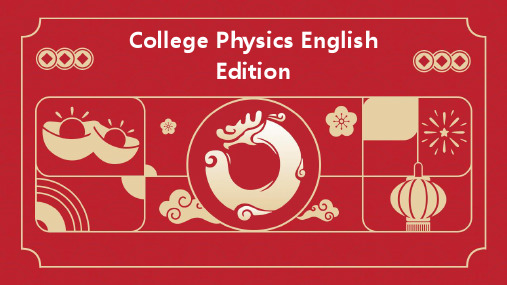
Elastic mechanics
When a force is applied to an object, it may under deformation If the force is removed, the object returns to its original shape and size, the deformation is said to be elastic
Polarization refers to the direction of these movements within the plane perpendicular to the direction of promotion
Polarization is a property of electrical waves and is observed in both natural and artistic sources of light
Angular Momentum
Angular Momentum is the rotational equivalent of linear momentum It is defined as the product of an object's mass and its angular velocity, and it is conserved in closed systems
要点一
要点二
Magnetic induction intensity
The magnetic induction intensity or magnetic field strength is the magnet of the magnetic field at a given point in space
大学物理教学 51.量子力学基础-2

V
dV Cψ dV 1
V
2
2
例:讨论一维自由粒子在空间各点出现的概率。
解:各点概率相等。
2 ( x ) x, t 0 e 2 i
( x, t ) 0e
2 2 ( Et Px ) i ( Et Px ) h h
i
2 ( Et Px ) h
13
3. 定态薛定谔方程
若粒子所处的力场不随时间变化,则薛定谔方程可化简。 (r ,t ) (r ) f (t ) 设粒子的波函数为:
E
得: 定态薛定谔方程 由该方程组的解有
i Et (r ,t ) (r )e
14
i Et f (t ) Ce
3
● 波函数的归一化和归一化系数
2
与粒子(某时刻、在空间某处)出现的概率成正比.
粒子在某区域出现的概率还正比于该区域的大小dV.
某时刻、在(x,y,z)附近的体积元 dV 中,出现 粒子的概率为: K为待定的比例系数, 且随波函数而变。 2 2 dW ——概率密度 k ψ dW k ψ dV dV
求归一化的波函数和粒子的位置概率密度。 解:
归一化 条件:
-b 2
(x, t ) dx
2
b2 2
b2
-b 2
(x, t ) dx (x, t ) dx 1
2 2 b2
2 x 2 b A cos dx A 1 A -b 2 2 b b 0 x b ,x b 2 2 2 = (x , t ) = 2 2 x x=0处,概率最大! cos ( ) b x b 2 2 b b
大学物理阿基米德定律实验课件英文版Archimedes' Principle
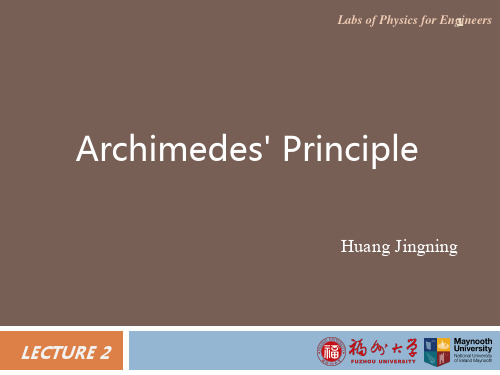
Vernier calipers
8
Reading A: 9 mm Reading B: 0.26mm Total: 9.26mm
Calculate the cross-sectional area
9
A D2 / 4
1mm2 106 m2
Measure the buoyant force of water
Place the object on the pan and wait for the screen to settle on the correct mass.
D
6 times each.
Calculate the volume of the cylinder
h
A= D2 / 4
V Ah
Measure the mass of metallic cylinder
15
Press the “on/off” switch and wait till “0.0g” is displayed .
Choose two points from the graph, read their coordinate values, then calculate the slope of graph.
slope
Ag
g = 9.79
m/s2
Procedure: Density of metal
13
Measure the density of the metallic cylinders by weighing them in air and Emqueiapsmuerninngt:their volume.
Apparent Loss in Weight = Weight of Liquid Displaced
重邮大学物理英文版PPT (6)
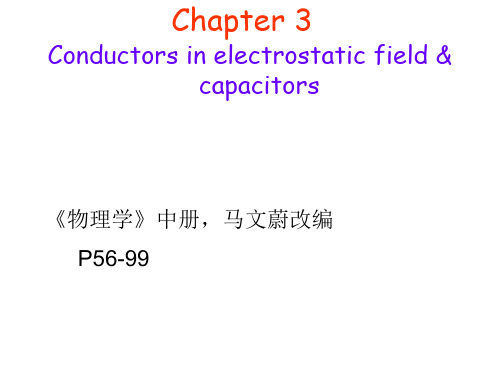
2) Electrostatic shielding 静电屏蔽 Cavity conductor空腔导体 a)No net charges inside the cavity conductor 空腔导体无净电荷 The external E field has no effect on the space inside the cavity. 外电场对空腔内部无影 响。可将仪器等放入空腔内部 起到屏蔽作用。
尖端放电
5) The surface of the conductor in electrostatic equilibrium is an equi-potential surface and the conductor is an equi-potential body. 处于静电平衡的导体的表面是一等势面,导体是一等势体。 Reasoning: Take one arbitrary path from point A to point B inside the conductor, the E potential difference between the two points is:
的电场是Q+q产生的电场的 的电场是Q+q产生的电场的 Q+q 叠加。 叠加。
*** If connect the external surface of the cavity to the ground, the external E field does not relate to E field inside the cavity. 如果腔外表面接地,则外场不受腔内电 场影响。
2) If the isolated conductor carries a net charge, the net charge resides entirely on its surface. 如果导体本身带有净电荷,那么这些净电荷将全部分布在 导体表面。 + + Reasoning: Gauss’s law
大学物理—经典力学
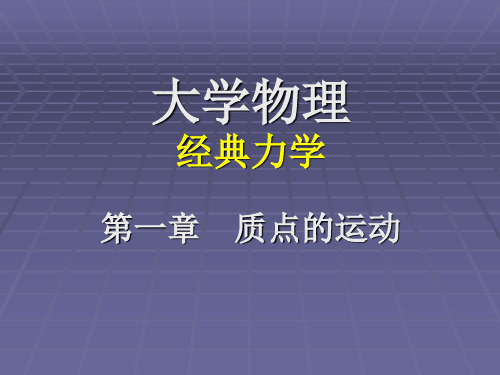
一个物体能否当做质点,是有条件的、相对的,取决于研 究问题的性质。
例如:地球绕太阳公转:地球可当做质点; 地球自转 :地球不可当 做质点 附:地球公转轨道平均半径:1.5×108 km,地球半径 : 6370 km 两者之比 :2.33×104
当一个物体不能当作质点时,可以把整个物体看作是由许 多质点组成的质点系(System of Particle)。分析这些质 点的运动,就可以弄清楚整个物体的运动。因此研究质点的 运动是研究实际物体复杂运动的基础。
•运动的绝对性与相对性 运动的绝对性: 所有的物体都在不停地运 动,没有绝对不动的物体 运动的相对性: 描述物体的运动或静止总是相 对于某个选定的物体而言的 演示
参考系的定义: 为描述物体的运动而选择的标准物称为参考系
•说明
•参考系的选择是任意的,主
要根据问题的性质和研究方 便而定。但在动力学中,就 只能选择惯性参考系。 •在描述物体的运动时,必须 指明参考系。 •若不指明参考系,则认为以 地面为参考系。
向质点运动方向的切向单位矢量,用τ表示,另一个是垂直于切向并指 向轨道凹侧的法向单位矢量,用n表示。他们也随质点位置的不同而不 同。 在自然坐标系中表示质点速度,非常简单,因为无论质点在什么位置 上速度都只有切向分量,无法向分量。 自然坐标系不仅适用于平面运动,也可用于三维空间运动。不过在三 维情况下,应该引入两个法向单位矢量。
在平面极坐标系中,极点P的位置矢量为: r (t )= (t ) e (t )
e (t )
是极径方向的单位矢量,长度为1,沿ρ增 大的方向。随着P点运动,极角在改变,单 位矢量也在改变,它是时间的函数。
P(ρ,θ)
ρ
O
θ
A
伯克利物理学教程SI版力学英文影印版第二版第1册教学设计 (2)
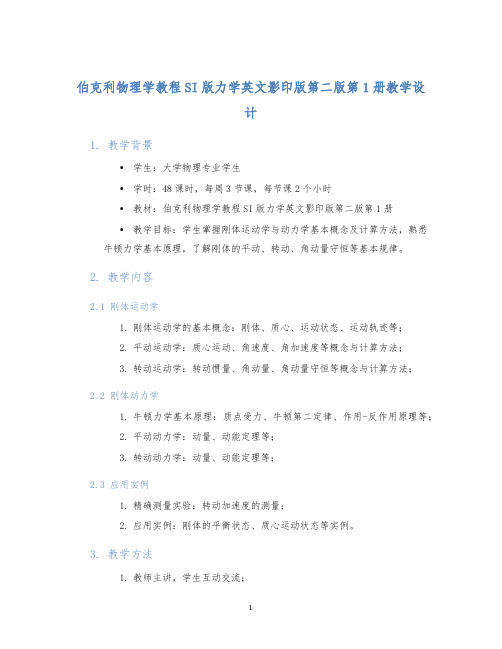
伯克利物理学教程SI版力学英文影印版第二版第1册教学设计1. 教学背景•学生:大学物理专业学生•学时:48课时,每周3节课,每节课2个小时•教材:伯克利物理学教程SI版力学英文影印版第二版第1册•教学目标:学生掌握刚体运动学与动力学基本概念及计算方法,熟悉牛顿力学基本原理,了解刚体的平动、转动、角动量守恒等基本规律。
2. 教学内容2.1 刚体运动学1.刚体运动学的基本概念:刚体、质心、运动状态、运动轨迹等;2.平动运动学:质心运动、角速度、角加速度等概念与计算方法;3.转动运动学:转动惯量、角动量、角动量守恒等概念与计算方法;2.2 刚体动力学1.牛顿力学基本原理:质点受力、牛顿第二定律、作用-反作用原理等;2.平动动力学:动量、动能定理等;3.转动动力学:动量、动能定理等;2.3 应用实例1.精确测量实验:转动加速度的测量;2.应用实例:刚体的平衡状态、质心运动状态等实例。
3. 教学方法1.教师主讲,学生互动交流;2.讲解课时结合实际应用案例,强化学生对基本概念的把握;3.布置力学练习题,引导学生利用所学知识解决实际问题。
4. 教学评价•组成:课堂表现、作业、考试等多种方式;•基本要求:学生掌握力学基本概念、原理及计算方法,能够独立解决基本力学问题。
5. 教学资源1.伯克利物理学教程SI版力学英文影印版第二版第1册;2.经典力学教材;3.相关力学实验设备。
6. 教学反思1.在讲解牛顿力学基本原理时,由于学生基础参差不齐,部分学生没有完全掌握向心力与惯量的概念,导致后续计算过程出现错误。
下一次讲解时需要针对这一点进行更加详细的解释;2.在讲解应用实例时,需要更加注重案例的实际性与可行性,引导学生将理论应用到实际问题中,提供丰富的例题。
